Cooking in Camper is one of those things,
that makes you feel at home wherever you are!
Gas, Diesel or Electric Stove? What equipment and accessories you need on the Road? How much space do you need? How to assemble the kitchen in your Camper?
In this article you will find EVERYTHING you need.
To create the right Kitchen for your Camper Van!
WHAT DOES THE KITCHEN IN AN RV INCLUDE?
The design of the kitchen in a DIY camper van certainly should start with an analysis of YOUR needs and the use you plan to make of YOUR vehicle in the future .
Do you plan trips of only a few days and eat out most of the time? Maybe a simple portable gas stove can be enough to make coffee in the morning and that occasional pasta now and then.
Do you plan long full-time periods on the road with your camper van? In this case you will probably need a stationary stove, a large refrigerator, a sink, kitchen equipment, and furniture where you can store everything.
And certainly between those two extremes, there are a thousand other possibilities: might you need a microwave? Are you thinking about a kettle? An oven? etc. etc.
In this All-in-One article, we take a detailed look at each detail you might consider in creating your DIY Campervan Kitchen.
Among the topics we’ll cover, you’ll find: layout ideas (with photos), how to choose the right stove for your needs (gas, diesel, or electric?), the best freezer-ovens-microwaves for RVs (with wattages and guides on how to install them), guidelines to keep in mind when building cabinets, kitchen equipment, space-saving ideas, and more.
I really hope you find this long guide helpful and inspirational in planning and building the kitchen for your future campervan (or upgrading your current RV too 😉 )!.
Happy Reading 🙂
TABLE OF CONTENTS
Kitchen for Camper | Best DIY Ideas for your Van Conversion
- Layout Ideas for a DIY Campervan Kitchen.
- Tips for designing your Layout
- Choosing the Cooker for Your Camper: Gas
- Choosing the Cooker for your Camper: a Diesel
- Choosing the Cooker for your Camper: Electric and Induction
- The Fridge and Freezer in the Camper
- Oven or oven?
- Microwave, Micro-oven or Kettle
- The Sink
- Kitchen Furniture
- Equipment for Cooking in the Camper
- Conclusion: the 15 Best Apps for Road Trips and Vanlife
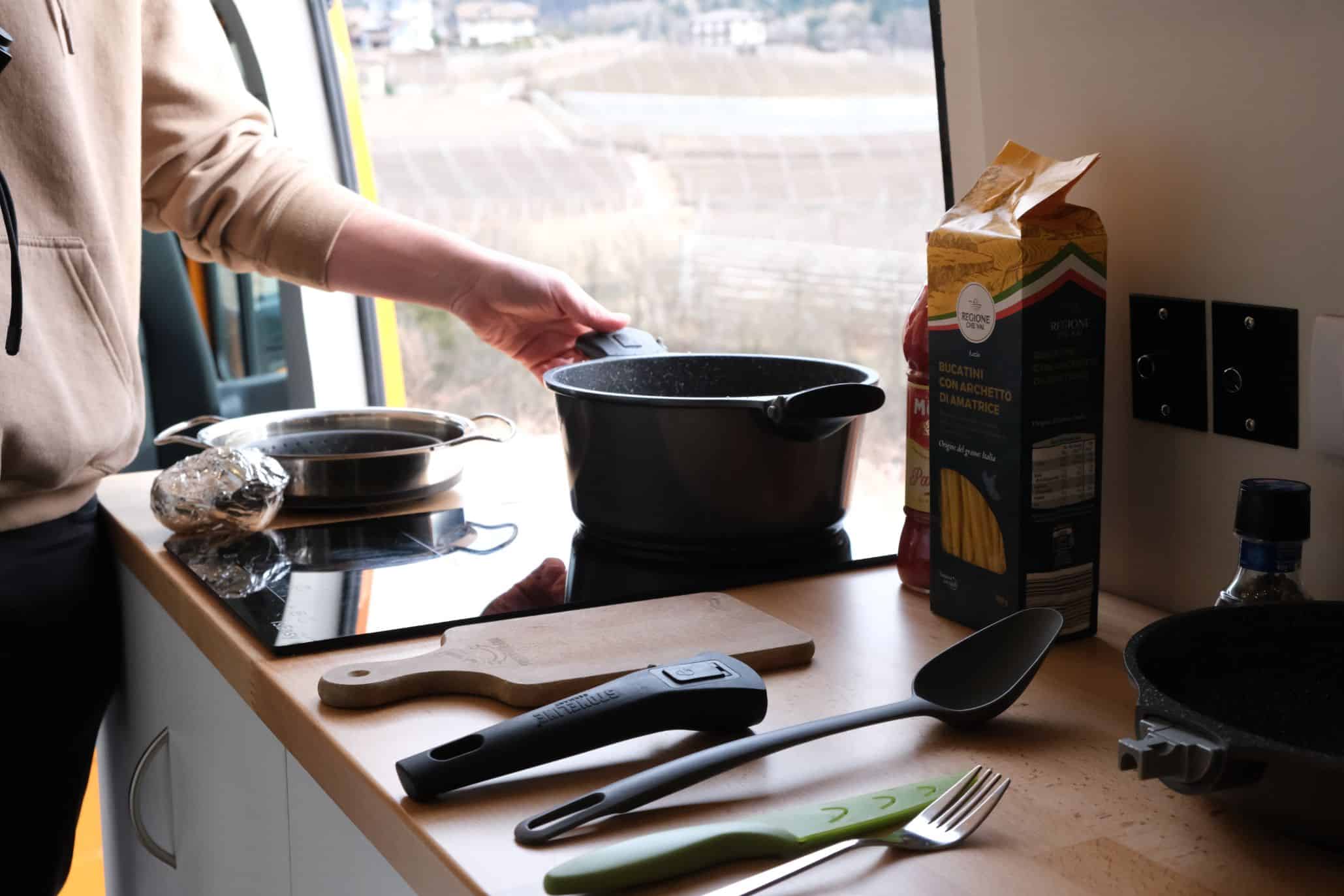
Do you want to support LostOnTheRoute?
All of the Guides I publish on this blog are free and usable by anyone because I personally am a firm believer that information should always be a public good and accessible by anyone and not a commodity to be purchased. Sharing is caring 😉
That said, maintaining a great blog full of detailed articles takes a lot of time, a lot of beer (of inspiration ahah) and most importantly implies economic costs sometimes not so obvious too.
If you would be interested in helping with the costs of the blog, you can consider purchasing any of the recommended products through the links on this page or in the Amazon storefront. LostOnTheRoute in fact participates in the AmazonAffiliate program, and for every product purchased through the links, I receive a small commission, obviously at no extra cost to you🙂
Happy reading and have fun with your project!:) 😀
Dani

Check Out All DIY Van/RV Products of tested quality, in one place.
1. Layout Ideas for a DIY Campervan Kitchen.

Creating the kitchen best suited to your vehicle and your needs definitely requires good planning, which should start even before you touch the work tools.
Understanding how much space you necessarily need, how to access it, how to power your stove, and what accessories you consider essential are all important points that will help you design the right layout for your project.
Before we get into the details of each of these topics (and many more!), I want to leave you with some photos below of Kitchen Ideas for a DIY Van Conversions, which might serve you as inspiration to start figuring out which layout is right for you and stir up the creativity you surely already have in your head 🙂
1.1 HORIZONTAL KITCHEN BEHIND THE SEATS
The first layout option we see, is the kitchen placed perpendicularly behind the cockpit. It is an ideal solution for those who want the kitchen “out of the way”: in the front you cook, and in the back you live.
Since the interior width of all vans (and cars!) is always generally between 130-190cm, it goes without saying that this kitchen option can be adapted to all types of vehicles: both large vans and medium-small vehicles.
I advantages of this type of RV kitchen are:
- You use space that is often difficult to use as storage space
- The kitchen does not shrink the rear “corridor”
- Remains ample space for bed/benches/dinette and bathroom in the back
- Vertical space can be used to install refrigerator, spice rack, oven/oven, storage drawers, etc.
The Disadvantages of the kitchens split on both sides are:
- The kitchen could block the interior passage between the driver’s seats and the back (which can be remedied, for example, with a removable work surface)
- Does not allow the installation of swivel plates for the front seats
- Depending on the location of your batteries/water tank, it may be more complicated to connect to services
Inspiration Photo – Camper Kitchen Perpendicular Behind the Seats
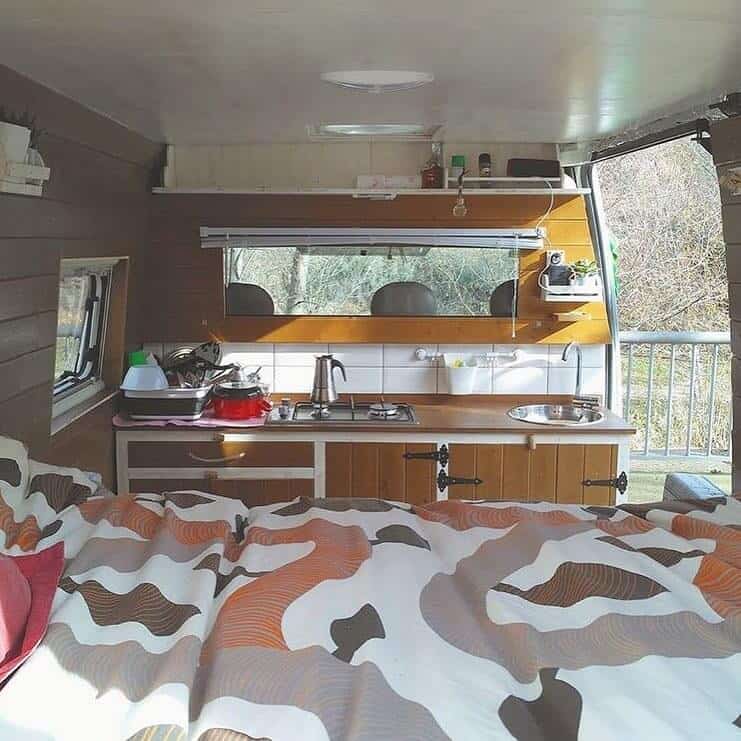
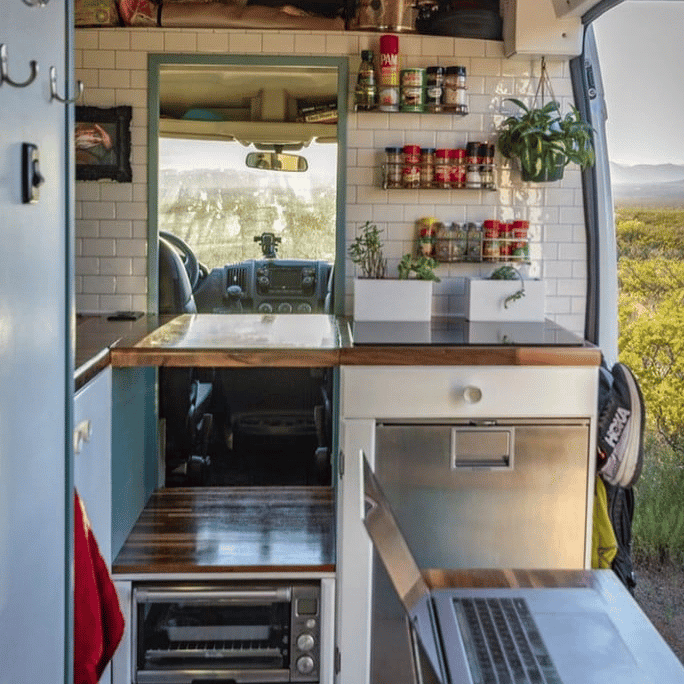
1.2 KITCHEN ALL ON ONE SIDE
Another popular option, is to place the entire kitchen (mainly sink, stove and refrigerator) on one of the sides of the van. This option, suitable mainly for somewhat longer vehicles, not only allows a transition between the driver’s compartment and the living area, but also goes particularly well with a bed or dinette in the rear.
(If you are interested in learning more about RV Bed Layouts, I recommend reading the article How to Build a Bed in a Do-It-Yourself Camper.)
I advantages of this type of RV kitchen are:
- Sink and stove close together reduce the risk of littering on the floor
- All services (gas, electricity, water) in one easy-to-control place
- A single block with everything
The Disadvantages of kitchens all on one side might be:
- Keeping Water and Electricity close together can also be a problem in case of failure
- Measurements (worktop height and width) should be accurately measured to allow sufficient space for passage
Inspiration Photo – Camper Kitchen All on One Side
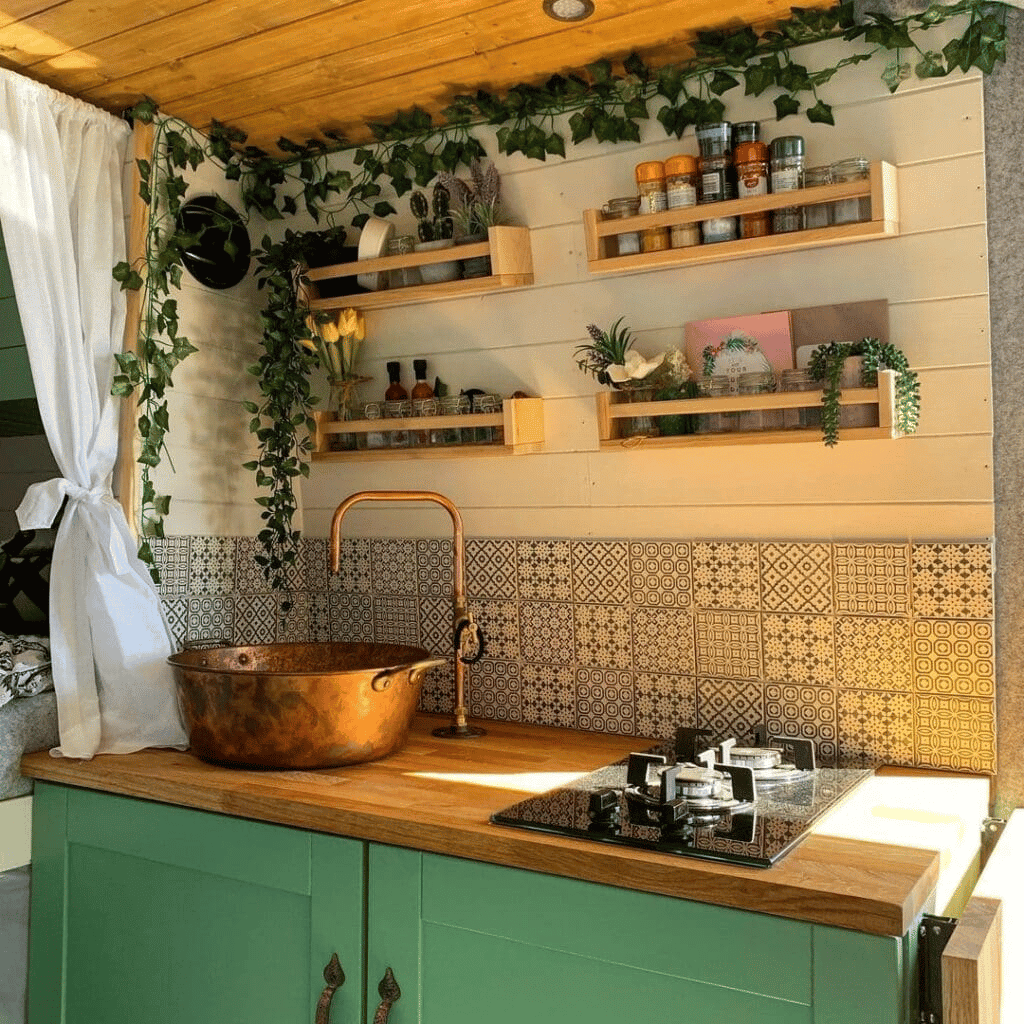
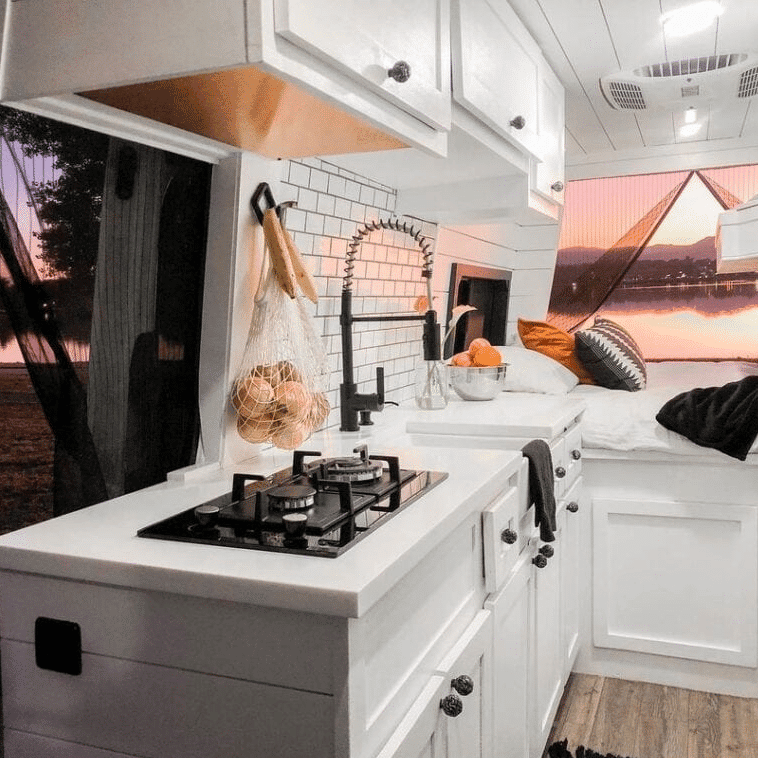
1.3 KITCHEN DIVIDED ON TWO SIDES
This is the layout I personally chose on my van: sink on one side and stove on the other.
My choice fell on this arrangement because, having planned my entire van with the electrical system on the right side and the plumbing system on the left side, this way I could also keep the induction hob (220V) separate from the sink (it gives me more security to have them apart).
If I had not chosen to cook with electric, I probably would have chosen another arrangement 🙂
I advantages of this type of RV kitchen are:
- You can keep utilities (electricity/water) separate
- While one person cooks on one side, another may have greater access to the sink
- It takes up less space longitudinally (space-saving choice for smaller van sizes)
The Disadvantages of the kitchens split on both sides are:
- When washing dishes, it is easy to get the floor wet (this can be remedied with a place for a dish drainer near the sink)
- To drain anything you have to change sides (it hasn’t happened to us yet, but sooner or later in life a pot will fall ;D
Inspiration Photo – Camper Kitchen Divided on Two Sides
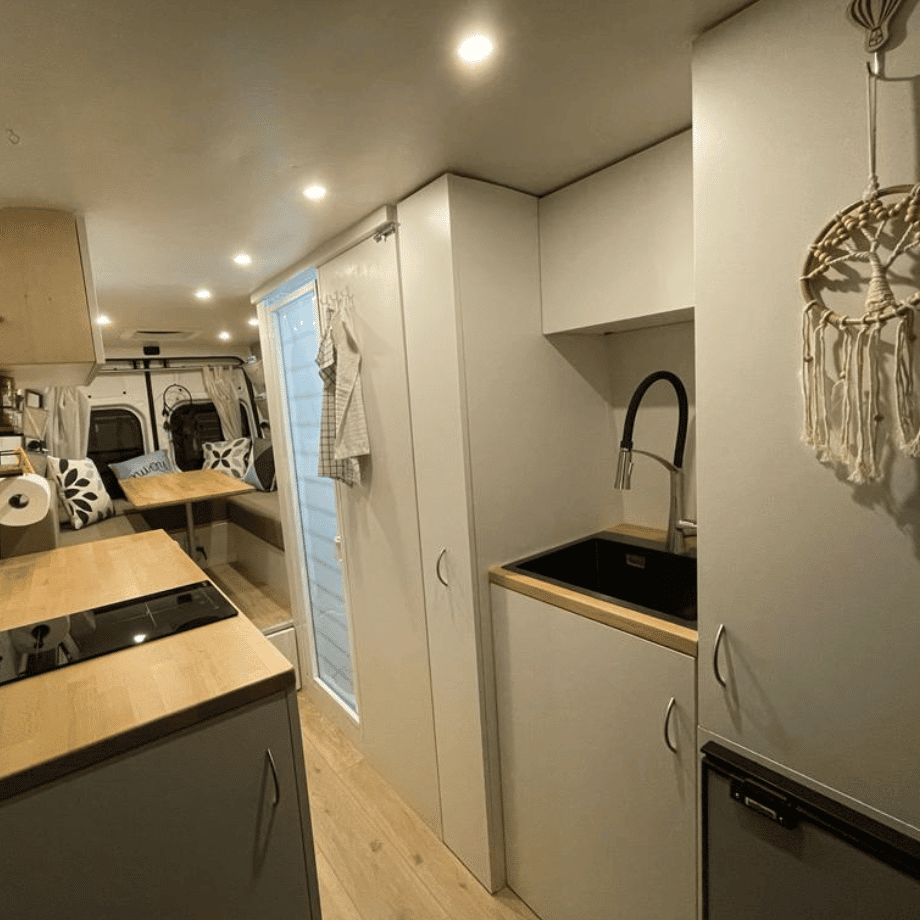
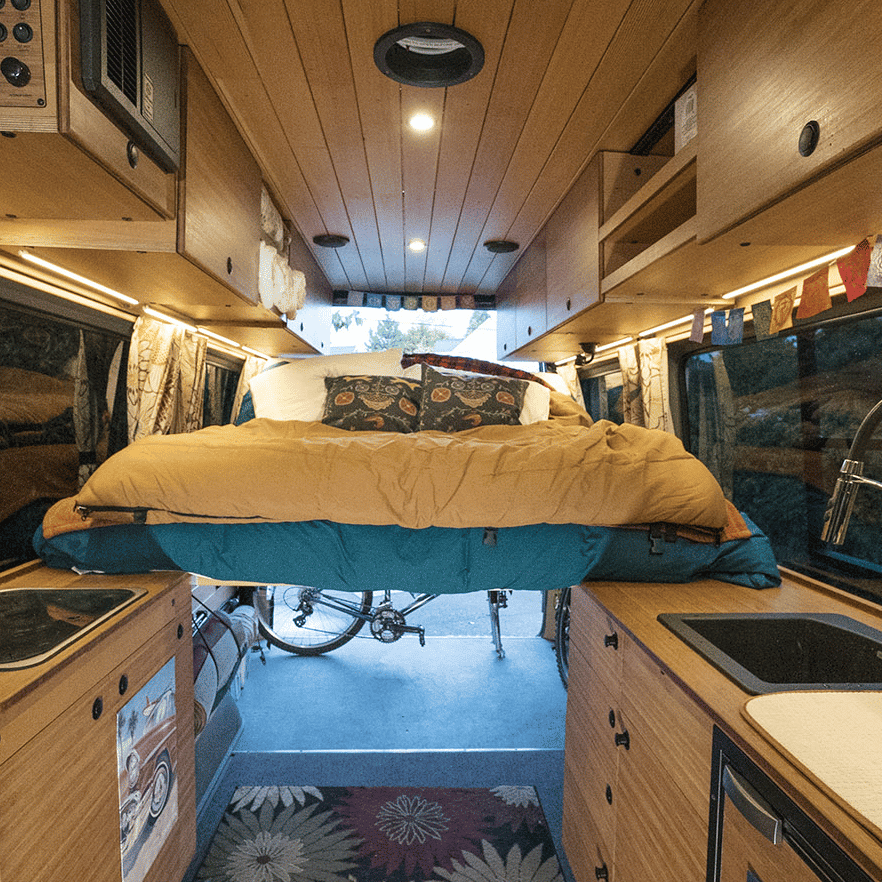
1.4 CAMPER KITCHEN IN A CORNER
For those who are not content and want a really big kitchen in their Van/RV, one option would be to build or install a corner kitchen.
This solution, positioned between the driver’s compartment and the rear, in addition to being aesthetically very attractive, is an option that certainly also provides ample storage space for all the accessories inherent in the kitchen.
I advantages of this type of RV kitchen are:
- Ample storage space for all kitchen accessories
- Aesthetically interesting and Particular
- The whole kitchen gathered in one corner
The Disadvantages of the kitchens split on both sides are:
- Probably more complicated than other DIY construction solutions
- It is necessary to calculate well that all doors have enough space to open without hindering the use of the kitchen too much
Inspiration Photo – Corner Camper Kitchen
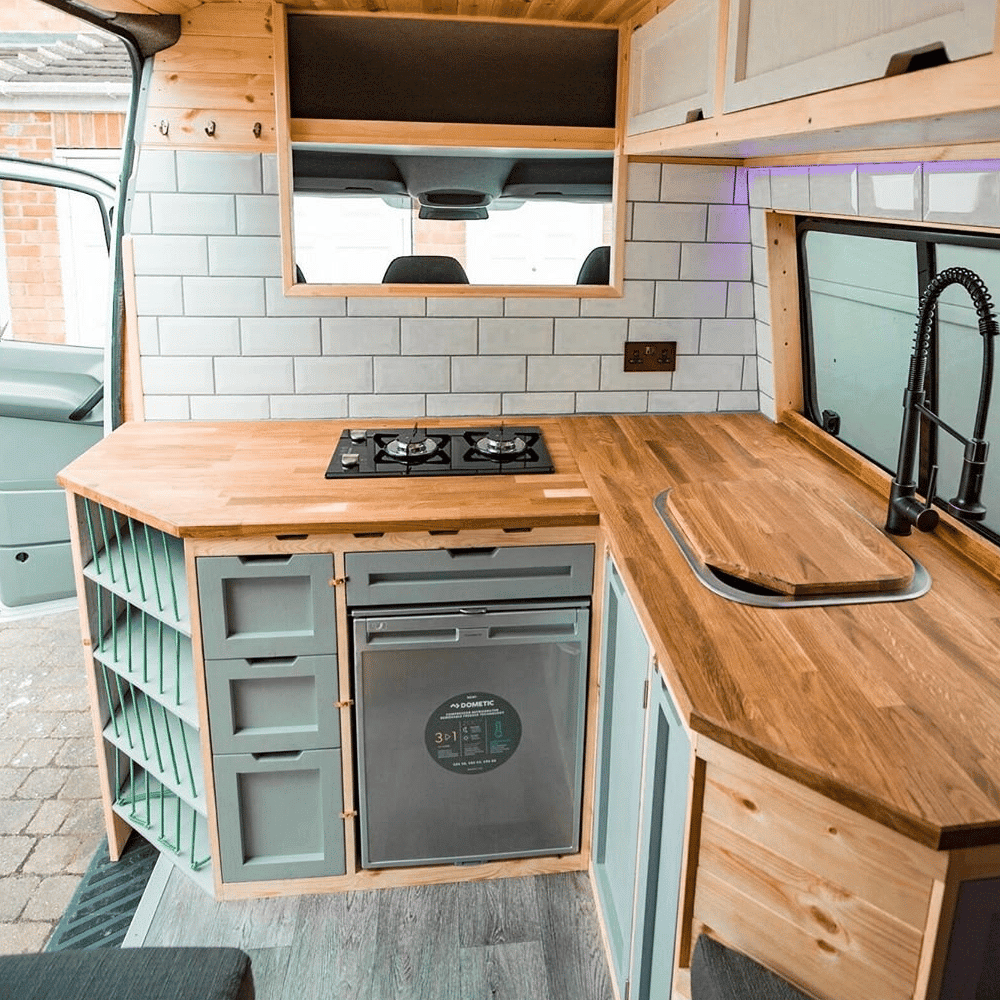
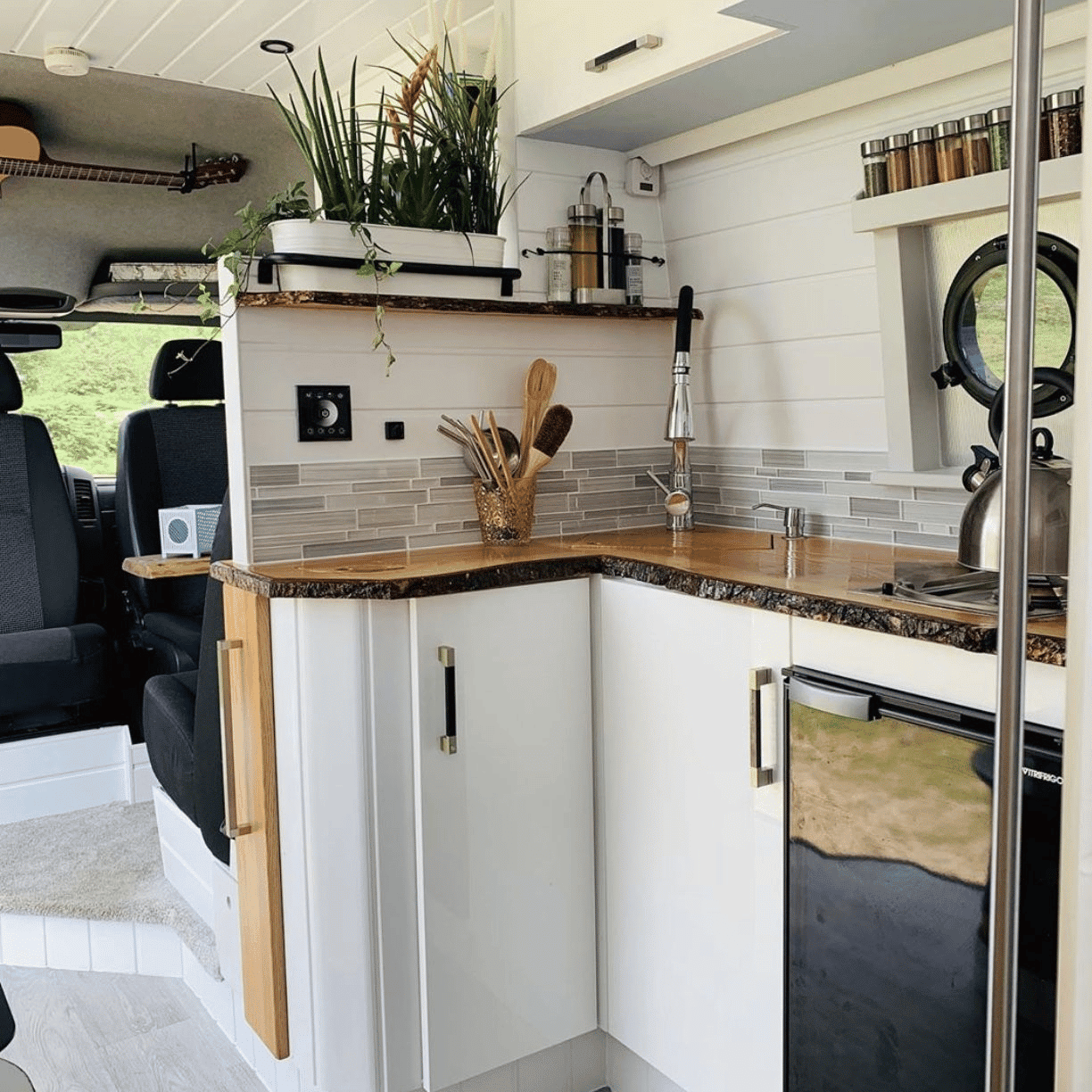
1.5 HORIZONTAL KITCHEN IN THE MIDDLE
A fairly rare arrangement, but one that I personally love, is the “half-van/horizontal kitchen”.
This special RV kitchen layout, is great for separating the living area from the sleeping area, and I personally find it makes a lot of sense in medium to large size vans with fixed beds.
I advantages of this type of RV kitchen are:
- It clearly separates the living area from the sleeping area
- You can use the back of the kitchen cabinets to pass all utilities (electricity cables and water pipes) from side to side Aesthetically beautiful and distinctive
The Disadvantages of the kitchens split on both sides are:
- Access to the bed could be complicated for people with limited motor skills
- Cooking near the bed could disturb (noise/smell) someone who is sleeping in it
- Not suitable for small Van
Inspiration Photo – Half Van Kitchen for Day/Night Separation
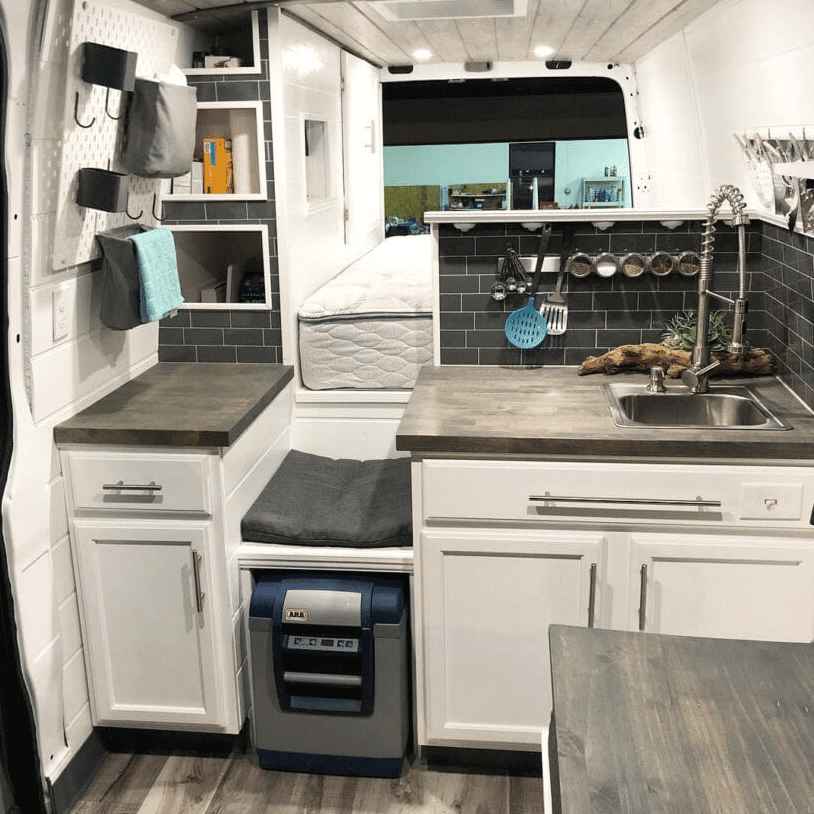
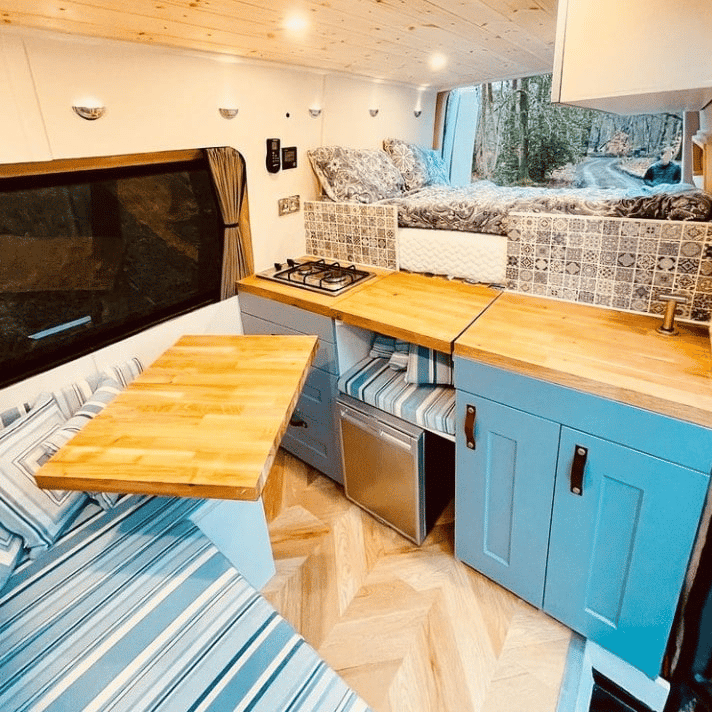
1.6 KITCHEN IN THE TRUNK OF THE VAN
You don’t necessarily need a giant van such as a Sprinter or Ducato to build a DIY campervan and hit the road: with ingenuity, it is possible to convert even small vehicles and equip them with all the comforts needed for several days of travel.
If your vehicle is medium to small (under 5m in length and perhaps with a low roof), aspace-saving kitchen idea might be to create it in the trunk.
I advantages of this type of RV kitchen are:
- You gain 60-70cm of longitudinal space (where you would normally stand in front of the stove)
- All the kitchen in one place
- Convenient kitchen for Pic-Nics and summer lunches outside
The Disadvantages of the kitchens split on both sides are:
- It is not 4 seasons
- With the rain, cooking can be very very complicated
Inspiration Photo – Kitchen in the Trunk of the Van
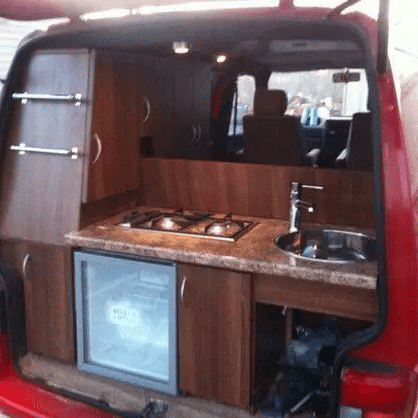
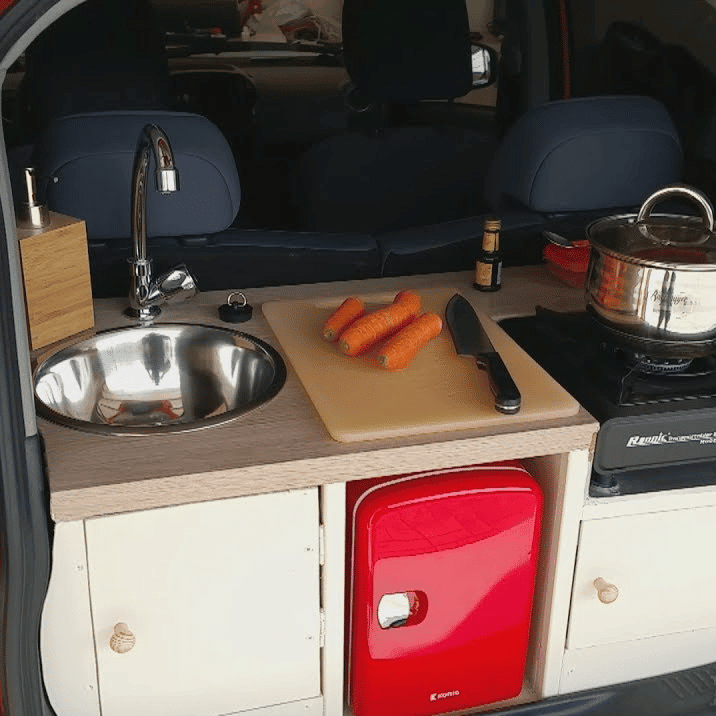
1.7 PULL-OUT KITCHEN
Even more space-saving than the previous one might be the pull-out kitchen. Again, we are talking about a mainly summer solution, or at least suitable for the warm weather and hot temperatures.
This type of kitchen is created by using “heavy duty” sliding rails and creating a pull-out modular kitchen.
I advantages of this type of RV kitchen are:
- Helps make use of empty spaces under the bed or furniture
- Space-saving: when not in use, the kitchen disappears
- Convenient and convenient for outdoor cooking and eating (nice season)
The Disadvantages of the kitchens split on both sides are:
- Not suitable for winter and rain
- Primarily limited to portable (gas) stoves and sinks with portable canisters
Inspiration Photos – Pull-out Camper Kitchen
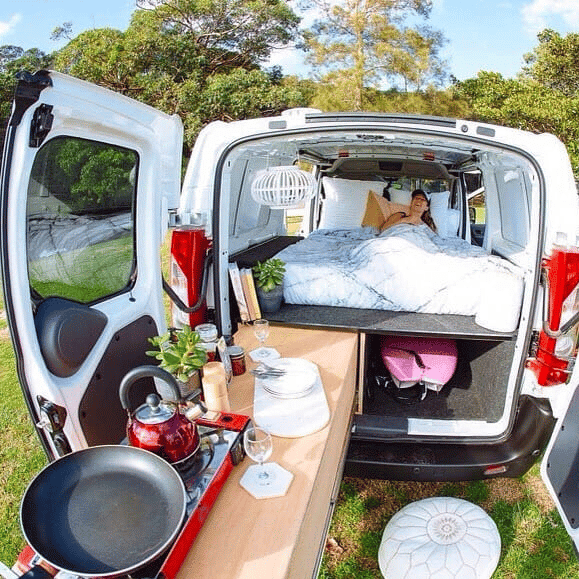
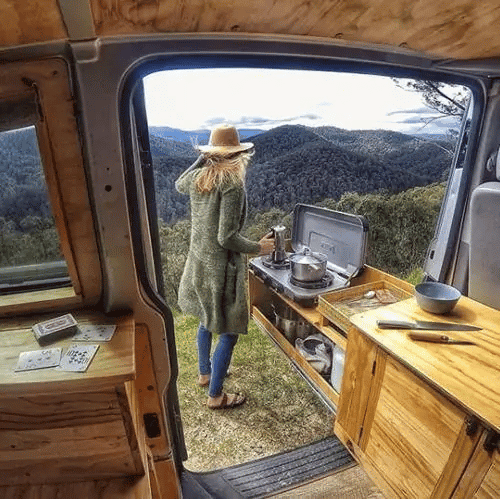
1.8 SPACE-SAVING STAND-ALONE KITCHEN
An additional space-saving solution for any type of van is to create a stand-alone kitchen-cabinet: refrigerator below, stove (and possibly even the sink) above. In a nutshell, with this layout you concatenate all the kitchen “essentials” into one compact block, sacrificing some of the storage space.
I advantages of this type of RV kitchen are:
- Compact turret with everything you need
- You can put it anywhere (ideally near a window/fan)
- All services in one place to do maintenance
The Disadvantages of the kitchens split on both sides are:
- Little storage space for utensils and kitchen equipment
- Work space for cooking minimized
- Requires design to the centimeter
Inspiration Photos – Kitchen Van Space-Saving Stand-Alone
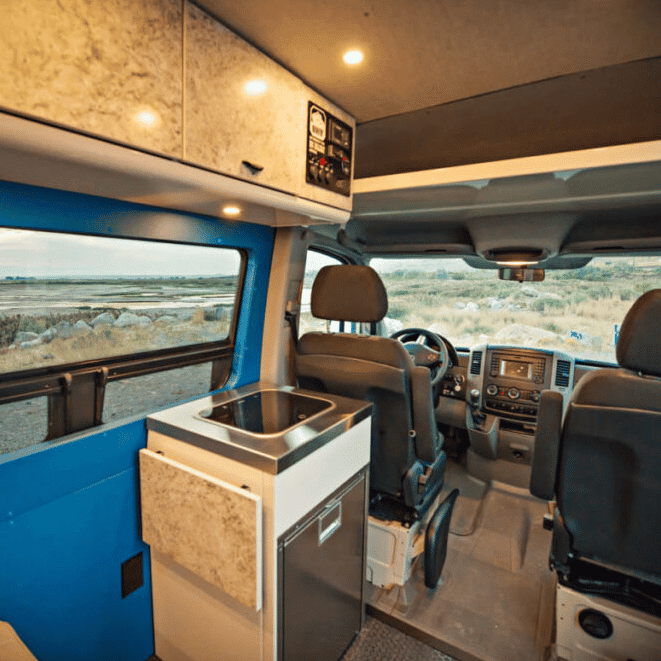
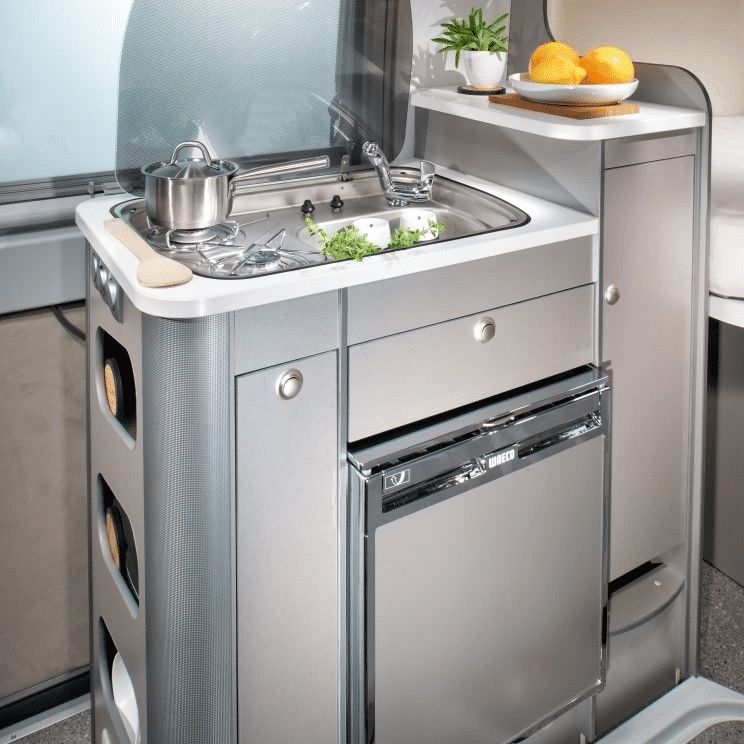
1.10 MORE KITCHEN IDEAS FOR A DO-IT-YOURSELF CAMPER.
These were some layout ideas for building a DIY Camper’s kitchen. Of course, the possibilities are endless!
Depending on the stove you choose (electric, gas or diesel? stationary or portable?), the size of the sink you choose, and the extra appliances you want to install (oven, microwave, kettle etc.), each individual option will probably need to be tailored to YOUR needs and preferences.
Continuing with the article, after some practical tips to keep in mind when designing your layout, you will find various options of stoves and accessories that you MIGHT want to include in your Do-It-Yourself Camper, of course with all the information you need to make wise and informed choices .
In the end of course, you will be the one to put it all together and create the perfect kitchen for your project tailored to your needs.
That being said, now that we’ve taken a look at some inspirational photos and you’re starting to get an idea of how you might structure your kitchen, let’s get into the meat of the article with useful practical tips for designing your van’s kitchen 🙂
2. Tips for Designing Your Layout.

Whatever kitchen location, stove, refrigerator, materials or model you choose, I think there are parameters essentially common to all van kitchens that I think you might need to keep in mind.
In this paragraph, I would therefore like to leave you with some useful tips to keep in mind that you may need when planning your kitchen space.
1.1 FIGURE OUT EXACTLY WHAT YOU NEED
Before you start with kitchen design, it is important to make a good wish list and figure out what you want to be able to fit and fit within your project.
Since space in a van is particularly limited (and therefore precious!), every detail counts. Therefore, I recommend that you think from the start not in general, but by already identifying the products you want to include, with clear dimensions from the start (it helps a lot to have a clear drawing even before you start assembling).
Among the things you should be thinking about right now are:
- The Cooker: How many fires do you need? How do you want to arrange them? Keep in mind that an average fire occupies about 30x30cm.
- The Utilities: to power the stove, sink, and refrigerator, you will need water pipes, electrical wiring, and perhaps a place for the gas cylinder. It is important to keep one step in mind for all this in the drafting process. In addition, some equipment (ovens, hot plates, refrigerator etc.) generally needs air intakes to cool down (it is always important to read the instruction manuals to properly install each electrical component in the kitchen).
- The Sink: do you want a recessed or a leaning sink? Concealed when not in use or always visible? A small sink can start from 25x30cm, however, it will be more difficult to use for washing large pots and pans. A very capacious sink can reach 45-50cm or more, however, it will obviously take up more space for other things.
- The Worktop: Depending on how you plan to use your kitchen, you may need a larger or smaller worktop. You could reuse the top of a cabinet, create a mobile one to use when needed, or simply cover the sink with a lid when not in use. The possibilities are many! Keep in mind that a comfortable countertop is normally between 85cm and one meter high (and a slightly taller countertop, can gain you storage space underneath).
- The Fridge: How spacious do you need the fridge to be? How do you want to feed it? What model to choose? How to position it so that it is accessible? On the choice of the Fridge (which I personally consider to be my go-to installation in an RV, because of course of its magical ability to chill beers), I wrote a dedicated article that you can find here Fridge for Camper: Which one to choose? Complete Guide.
- The Stowage Space: think about the space you need to Stow food (the more space you have, the greater your autonomy will be of food, and the less you will have to go to a supermarket to restock); think about the space you want to devote to stowing pots and pans, dishes, glasses, utensils, cutlery, dishcloths, detergents, worlds, recycling collection, other kitchen accessories etc. He thinks the furniture will need to be convenient to access, and have a locking system to use while walking.
- Other Appliances: isn’t a stove enough for you? Are you thinking about an oven? A toaster? A coffee machine? A Microwave? A kettle? Anything you’ll want to take with you certainly needs a space and convenient attachment to the facilities. Knowing from the start what you intend to install will help you set up your kitchen logically.
Once you have “done your homework” and identified everything you want to include, it will be much easier to design the layout of your ideal kitchen.
One piece of advice I can give you to get a good understanding of the spaces you need is to arm yourself with a tape measure, and start measuring the size of the kitchen in your home: this way you will realize visually how much space each thing takes up and what compromises you can make in your design.
2.2 IMPORTANT CONSIDERATIONS FOR PLANNING THE RIGHT LAYOUT FOR YOU
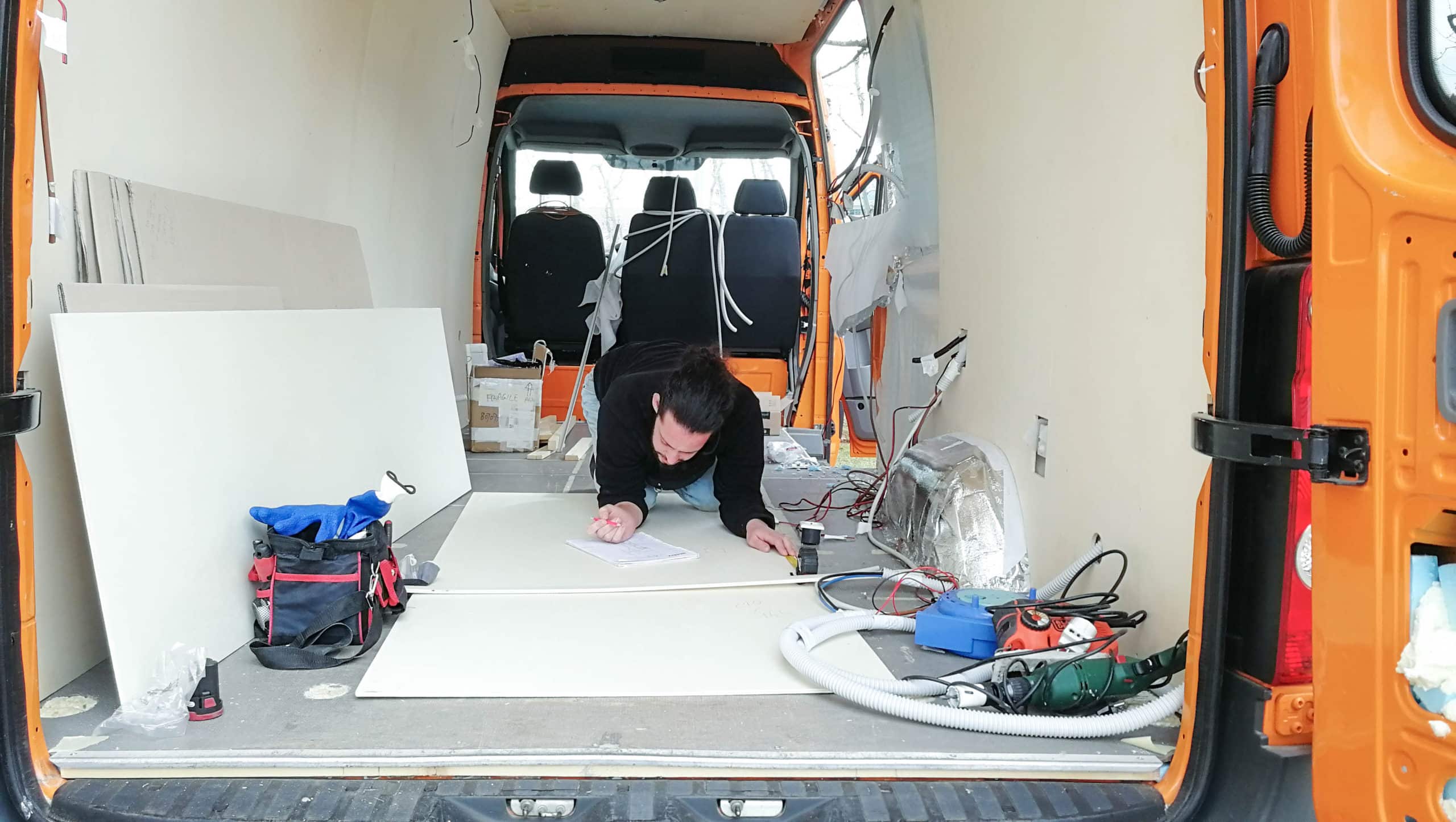
In addition to the accessories and spaces to be included, when planning the layout of your truck camper’s kitchen, I also recommend that you keep in mind:
- Ventilation: cooking produces steam and odors that you probably don’t want lingering inside your van for long. Besides avoiding particularly spicy recipes (we once made a chicken curry that stayed with us for 2 days ahah), it is important to locate the stove near a door, window, or possibly a ceiling fan (if you want to learn more, read the guide How to Install a Maxxfan on the Ceiling of Your Van.)
- The Passage: If you plan to travel with other people, make sure that the kitchen layout is functional to let other people pass if they wish (for example, without a removable countertop obstructing the passage).
- Accessibility for Maintenance: nothing is eternal, and over time everything can break down, regardless of how well a job was done. Therefore, it is important to think of your kitchen with accessibility in mind: in the event of a breakdown, everything should ideally be replaceable without having to spend hours disassembling and reassembling half of the RV.
- Lights and Lighting: cooking well requires light, which is why it is important to think carefully about the arrangement of any spotlights or under-shelf lights. Take care that light reaches all sides of the kitchen and the various drawers, even when these are open(avoid shelves, doors or decorations creating annoying areas of shadow around the work area).
Now that you’ve got a more or less clear idea of all the things to keep in mind when designing your kitchen layout, in the next chapters I’ll talk in detail about each component you might be interested in for your project.
Before I got around to choosing and composing the entire kitchen of my VW Crafter in fact, I did an abnormal amount of research on everything related to RV kitchens.
In this article, I want to leave you everything I have learned so that it will not be lost but put to good use 🙂
Let’s continue!
3. Choosing the Cooker for Your Camper: Gas
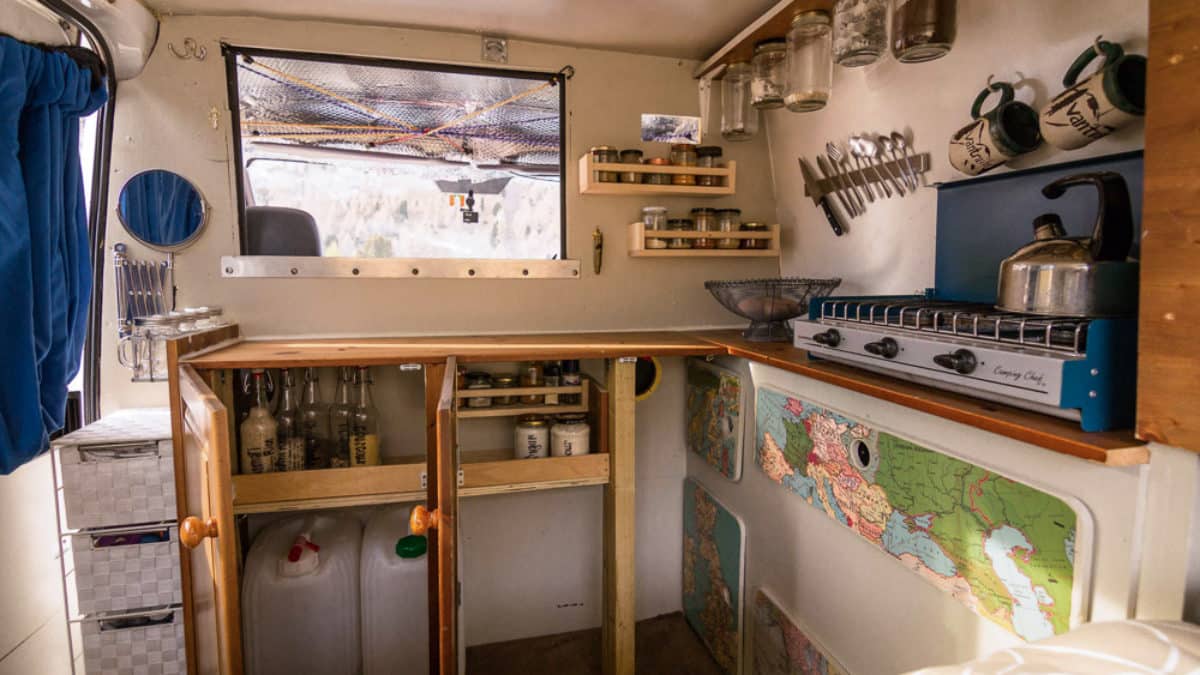
Choosing the power supply for your RV/Campervan’s stove will certainly affect its use, initial cost, and cost of operation.
The first option we see, are gas stoves.
RV gas stoves run on LPG (primarily propane) gas and are commonly used on almost all factory RVs.
Gas is normally stowed in cylinders (to be changed when finished, as at home) and in some cases in tanks placed underneath the van.
Below, I leave you with an analysis of the Pros and cons of gas stoves.
PROS AND CONS OF GAS STOVES IN CAMPERVAN/RVS
PRO
- Autonomy of a few weeks without problems, even in the highlands
- If your RV already has a gas system (e.g., for the refrigerator, heater, boiler etc.) it may be the most logical solution
- If you’re planning to install an oven as well, it probably makes sense to go with gas
- Portable cartridge cookers cost very little and are perfect for cooking anywhere, even outdoors
AGAINST
- Need to travel to change cylinders when they are empty (and it may not always be easy to find them abroad)
- In the Event of an Accident, having gas cylinders or tanks on board increases the risk of explosion
- Possibility of gas leakage
- The gas system must be certified by a professional (for overhaul or approval in EU)
- Free Flame inside the Van, besides being an extra gamble, produces more moisture
- Cylinders take up valuable space inside the van
Personally, if we’re talking about stationary stoves, I would only advise you to use gas in your vehicle in case it already has a certified gas system installed (so if you’re re-commissioning a factory camper or replacing an old stove).
On the other hand, if you are converting a van from scratch, I think the gas route is outdated (high maintenance cost, need to go to refuel, open flame etc.) and other gas-free solutions (diesel or electric) are both more convenient and safer.
Different discussion, however, is for smaller portable (cartridge) stoves: in this case, for those who make more occasional use of the stove or love hiking, a cartridge stove may be the fastest and cheapest solution for cooking wherever you are (also for emergency backup works great!).
Below, I leave you with four examples of the most popular gas stoves on the market:
3.1 KEMPER STOVE
BEST COUNTERTOP GAS STOVE
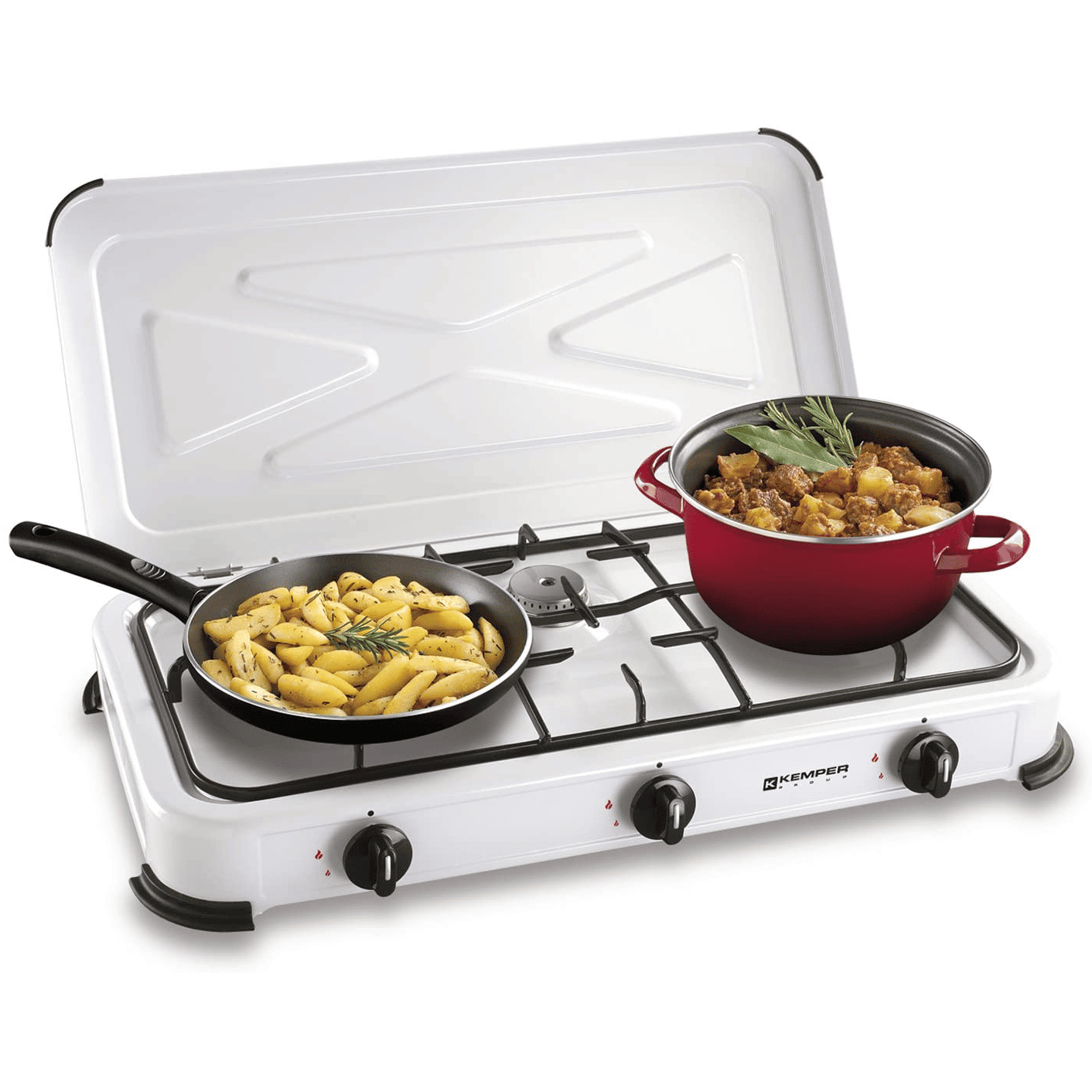
FOR: Camper/Camping, Save Money, Not Full-Time
DIMENSIONS AVAILABLE: 1-2-3-4 Fires.
POWER SUPPLY: LPG
When it comes to gas stoves for RVs and camping, Kemper is definitely one of the undisputed leaders in the industry.
If you are looking for a countertop solution that is resealable and can be used both inside your RV and outside, the Kemper stove is definitely a solid, quality choice.
TECHNICAL FEATURES
- Reclosable Standing Stove
- Easy to Disconnect and Connect to the Cylinder
- Space-saving when not in use
- Stainless Steel and Non-Slip Feet
3.2 NOXTON STOVE
BEST BUILT-IN GAS STOVE
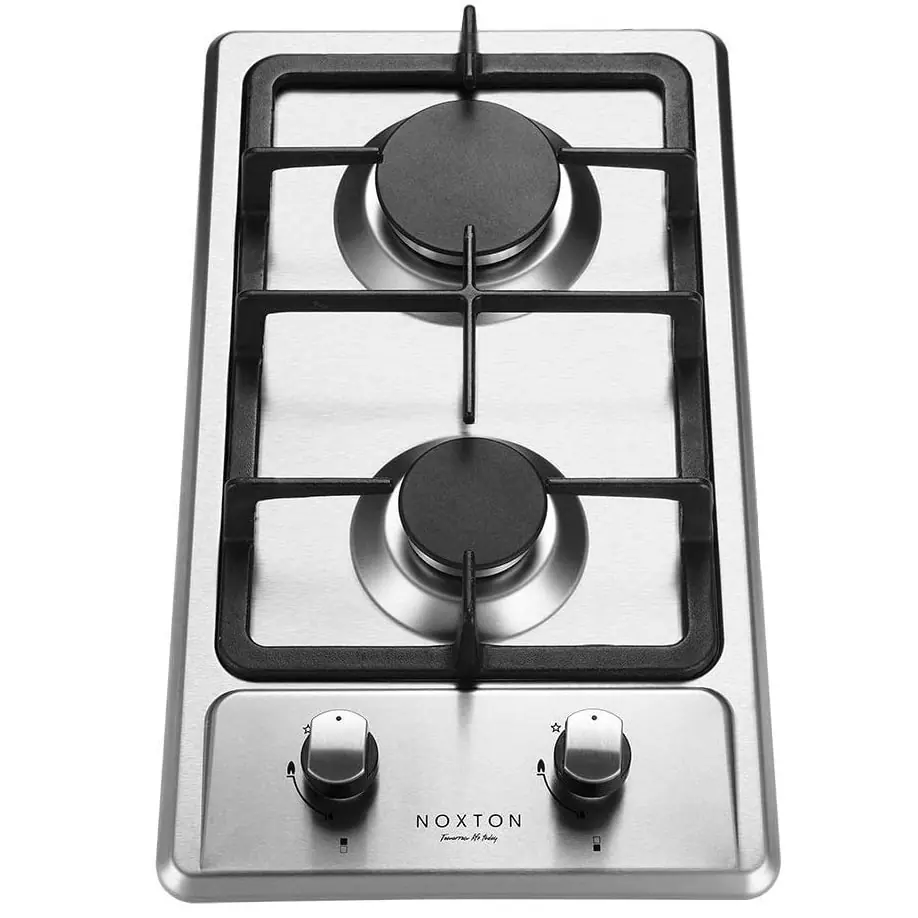
FOR: Fixed Setup, Full-Time Use as well
DIMENSIONS AVAILABLE: 2-4 Fires.
POWER SUPPLY: LPG
Whether we are talking about gas or electric cookers, Noxton is always a safe and quality choice.
A famous brand for house stoves, I personally find this type of stove also perfect for a stylish camper project.
TECHNICAL FEATURES
- High Efficiency (Energy Class A)
- Automatic Thermocouple Protection against Gas Leakage (if the flame does not ignite, it automatically shuts off the gas)
- Very Easy to Install
- Elegant Design and Easy to Clean
3.3 DOMETIC STOVE
BEST READY-MADE STOVE WITH SINK
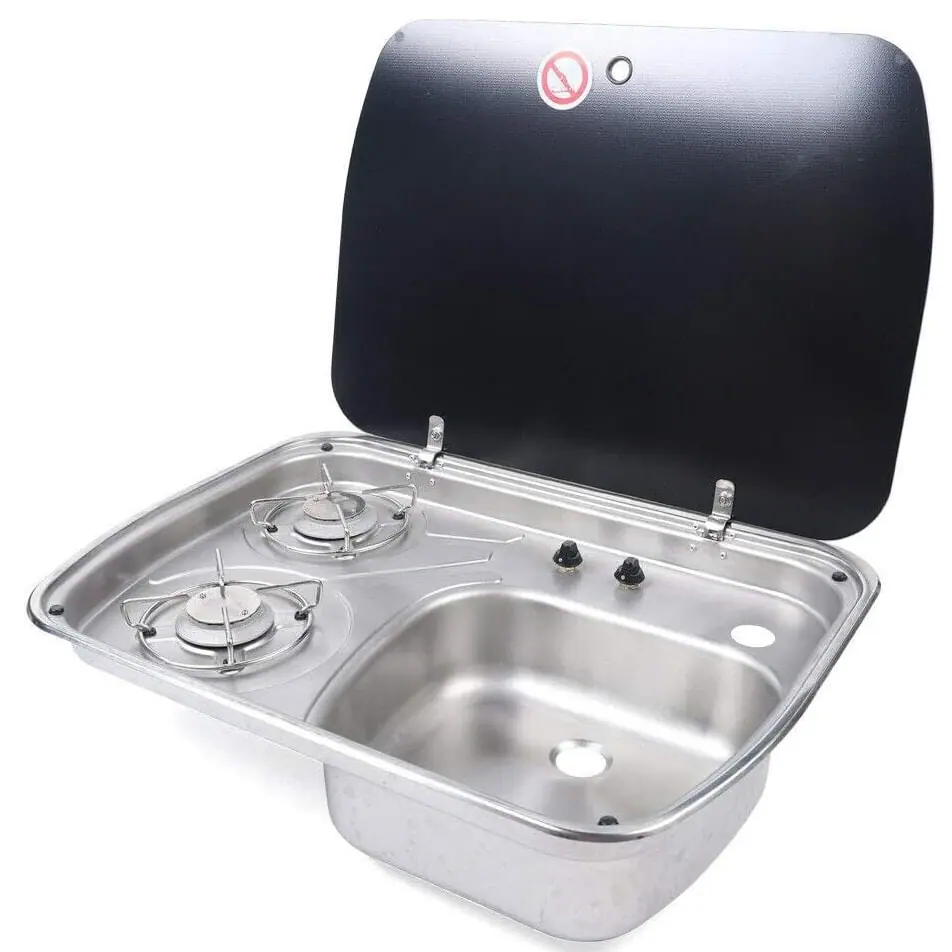
OVEN FOR: Fixed Setup, Ready-made Solution
DIMENSIONS AVAILABLE: 1-2-3 Fires.
POWER SUPPLY: LPG
Dometic is a brand that needs no introduction in the RV world. This type of stove/sink is a classic on most factory motorhomes .
Personally, I find it aesthetically mediocre, but I understand the functionality and convenience of having a “ready-made” piece.
TECHNICAL FEATURES
- Stove and Sink with Hardened Glass Lid
- Easy-to-clean anti-drip tray
- Includes Anti-Flame device
- Being a ready-made piece, obviously the price is high
3.4 CARTRIDGE KEMPER
BEST PORTABLE AND OUTDOOR COOKING STOVE
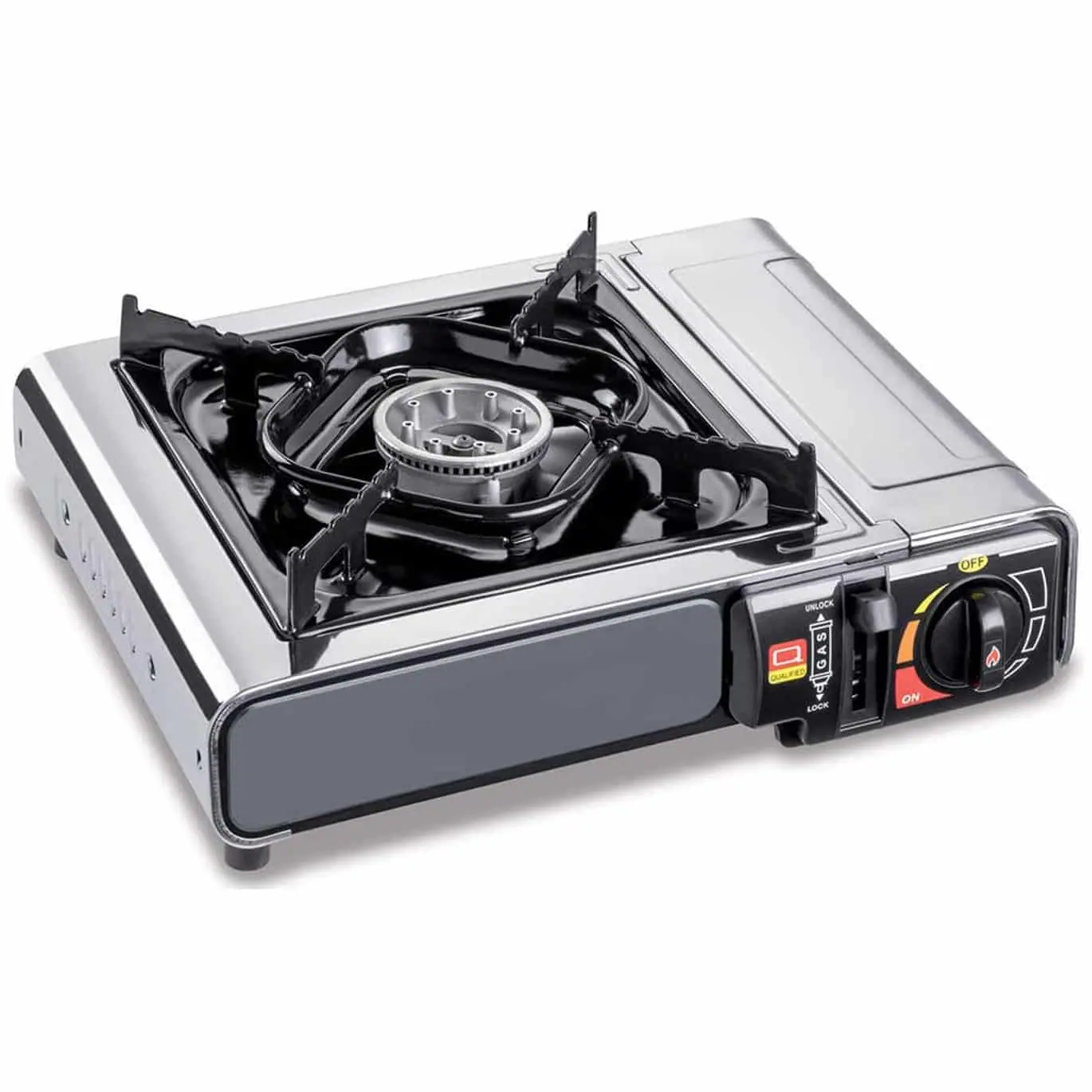
FORK FOR: Picnic, Occasional Use, Outdoor Kitchen
DIMENSIONS AVAILABLE: 1 or 2 burners
SUPPLY: Propane Cartridges
The most famous, popular, copied and functional portable stove in existence.
The Cartridge Kemper is the ultimate economical solution for outdoor cooking. Of course, for short trips it can also work very well as an indoor stove.
I purchased one that I keep in the garage of our van for when we want to cook outdoors, and I must say it works great.
TECHNICAL FEATURES
- Adjustable Flame Power
- Accidental Overheating Protection
- Turns on with a click, easy to use and put away
- Economical, functional and energy-efficient
- Note: If used regularly for everyday cooking, the cost of cartridges may become significant
4. Choosing the Cooker for your Campervan: Diesel (Diesel Fuel)
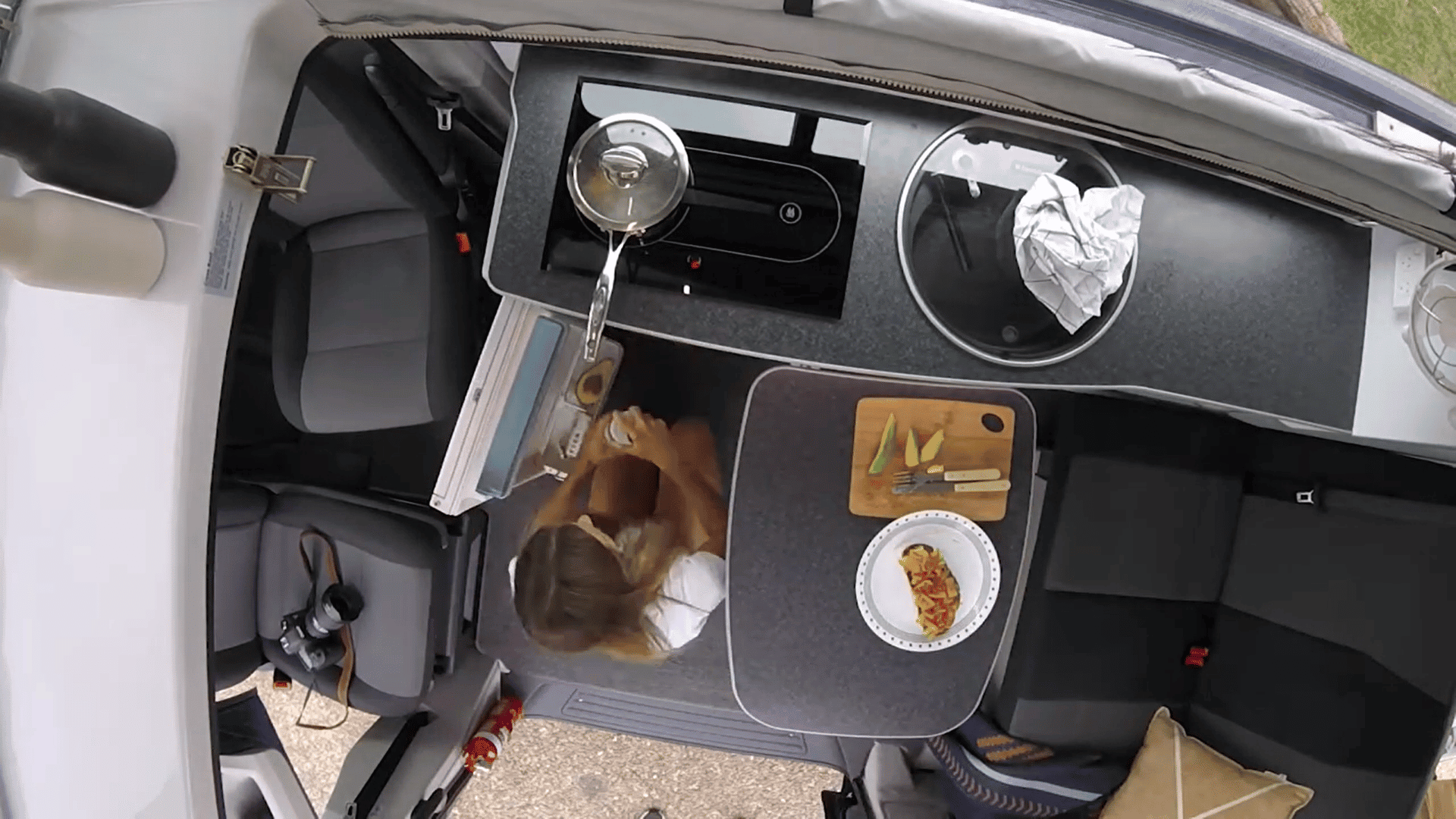
The diesel (gasoline) stove for RVs is a relatively modern and still underused technology that uses diesel fuel in the vehicle’s fuel tank as its fuel supply.
Drawing directly from the tank, these types of stoves have an almost unlimited range: as long as there is gasoline in the tank, there is energy for cooking.
The combustion also does not release any exhaust gases inside the vehicle (it burns air from outside and releases it to the outside of the RV).
Below, I leave you with an analysis of the Pros and cons of diesel stoves:
PROS AND CONS OF A DIESEL CAMPER STOVE
PRO
- No Free Flame inside the Van
- Fuel Easy to Find Everywhere
- Elegant as an Induction Hob
- They work at any altitude and at any outdoor temperature
AGAINST
- The Most Complicated to Assemble Do-It-Yourself
- The Least Ecological of all the Options
- There are only a few models and they are very expensive
Personally, I think diesel stoves are the best option to make sure you have a working stove wherever you are (in the end, it is very difficult to run out of fuel), at any altitude and at any temperature.
In the case of my van, having already invested in a very large electrical system (both in terms of solar and batteries and charging systems), I preferred to install an induction cooktop that as an initial cost certainly costs less and operates at virtually zero cost (thanks to solar power).
That said, I have long considered the diesel option, and if I had not at the time already invested in a very large electrical system, I probably would have gone with a diesel stove.
In fact, from my point of view, the diesel cooking is much more practical and safe than a gas system. Obviously, given the very high initial cost, this type of stove is suitable for those who plan full-time or near-full-time use of their vehicle; whereas it may be a cost that is perhaps too exaggerated for vacational use only.
Below, I show you the only two diesel stove options I have found that I consider competitive in terms of quality/price:
4.1 WEBASTO DIESEL COOKER X100
BEST DIESEL STOVE
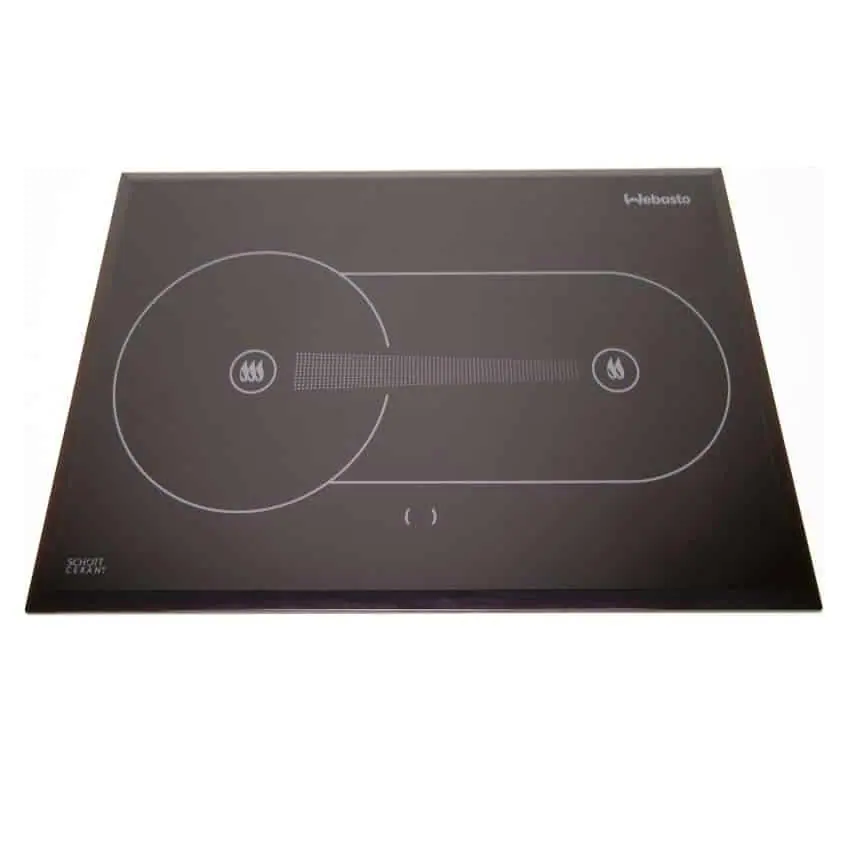
OVEN FOR: built-in, fixed setup, diesel stove
DIMENSIONS AVAILABLE: 2 Burners
POWER SUPPLY: diesel/diesel.
As you have probably already seen in the Guide to Heating a Motorhome, where there is heat in a motorhome there is Webasto.
Even in the case of the stove, this German company offers a model that is certainly cutting-edge and created to impress.
TECHNICAL FEATURES
- Easy-to-clean glass-ceramic surface
- Led signals remaining heat on the plate
- Consumes very little: 0.09-0.18Liters/hour
- Power between 0.9-1.9KW
- Negative Note: VERY High Price (1500-1600 Euro)
4.2 JP DIESEL COOKTOP
THE CHEAPEST DIESEL STOVE

OVEN FOR: built-in, fixed setup, diesel stove
DIMENSIONS AVAILABLE: 2 Burners
POWER SUPPLY: diesel/diesel.
In addition to excellent heaters (I bought one for my VW Crafter), the Chinese company JP Heater has recently launched into the production of this new model of diesel stove.
The stove arrives with all the kit needed for a Do-It-Yourself assembly and the price is less than half the price of a Webasto stove. Definitely a more than attractive option.
TECHNICAL FEATURES
- Easy-to-clean glass-ceramic surface with lid
- Equipped with Complete Kit for Do-It-Yourself Assembly
- Consumes very little: 0.11-0.26Liters/hour
- Power between 0.9-2.2KW
- Excellent value for money (costs around 600Euro)
5. Choosing the stove for your Camper: Induction Cooker
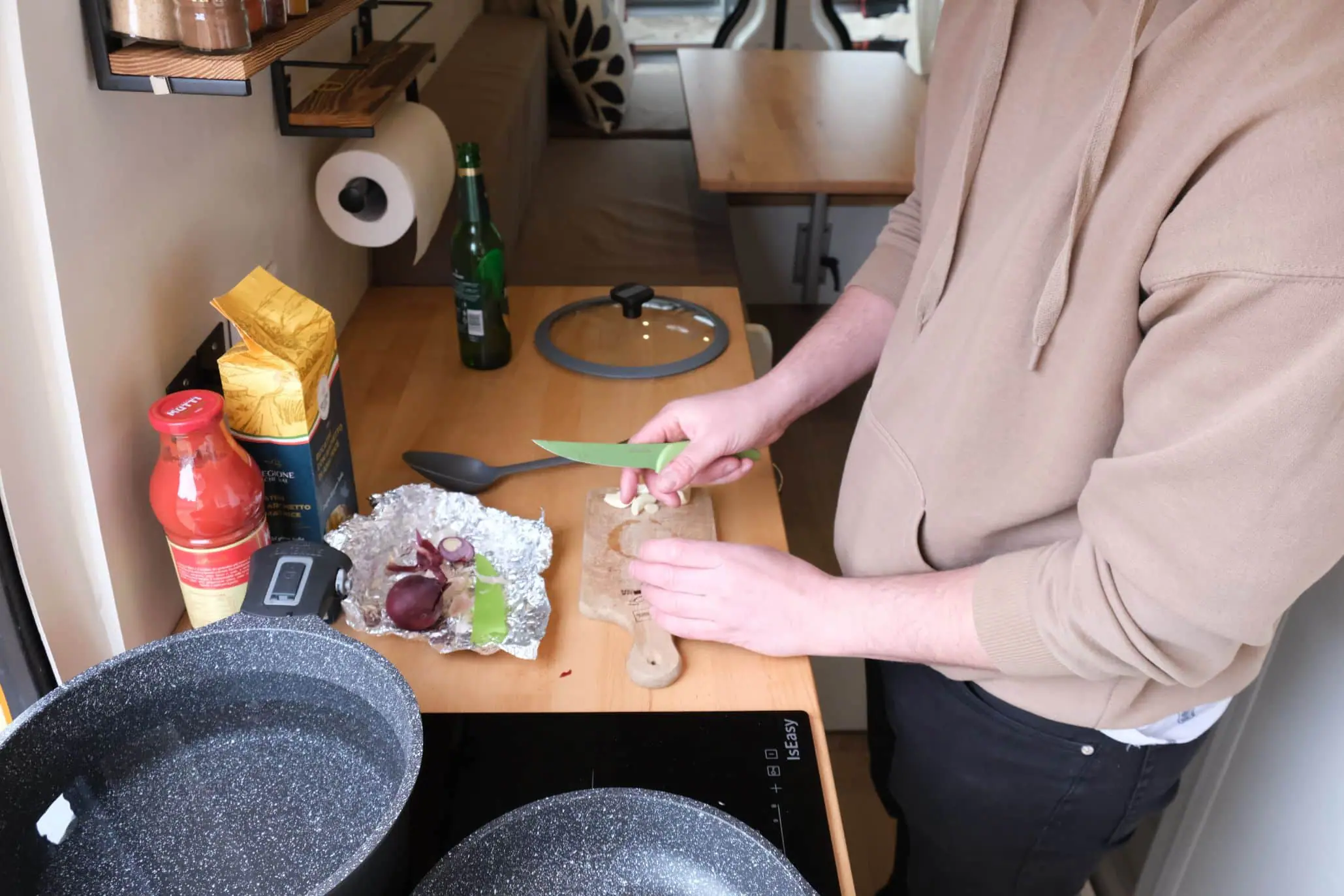
The third stove option we see is the more modern and environmentally friendly option that more and more DIY RV enthusiasts are choosing to adopt: electric.
When we talk about electric hotplates, it should be pointed out that there are two types: induction hotplates and glass-ceramic hotplates .
Induction hotplates work by generating heat through magnetic fields, while glass-ceramic hotplates produce heat by heating an electrical resistance.
Induction cooktops are faster and more energy efficient than a thermoelectric hotplate, and between the two options they come out as clear winners on all fronts. Therefore, in this paragraph I will not cover the topic of glass-ceramic further (it is an option dominated by induction), but I will focus on the best option: induction.
Having said that, let us now look at the pros and cons of an induction hotplate:
PROS AND CONS OF AN INDUCTION CAMPER STOVE
PRO
- The only costs are the initial cost of the plate (usually low) and the cost of electricity (zero if it comes from solar panels)
- No flame inside the van
- Power is Easy to Calibrate with Digital Settings
- Elegant, Modern and Easy to Clean Design
- The Plate Does Not Burn (Induction)
- Does Not Increase Moisture in the Van
- If the stove is solar powered, it is the most sustainable and environmentally friendly solution for cooking
- A piece of cake to install (just plug it in)
AGAINST
- Extremely energy-intensive: for wild camping, it requires an electrical system that can support it (which can cost a lot)
- In the absence of a sufficiently large service battery bank (min. 300ah Lithium), needs 110-220V electricity from the grid
- Slight hum when set to high settings
- Needs pots/pans specifically designed for induction cooking
The advantages of induction are many and unquestionable: modern, stylish, clean, sustainable, economical.
Obviously, however, to support an induction hob, a proportioned electrical system is required (batteries, solar panels, inverter etc.) and that yes, it can have a significant cost.
If you are interested in learning how to understand how much power you might need, how to build a Do-It-Yourself electrical system, and all the components you might need, I recommend reading the in-depth article Complete Guide to a DIY Van Electrical System (with Diagram!).
Below, I show you 2 models of RVinduction hotplates that I personally bought and can recommend that you consider for your kitchen:
5.1 PORTABLE AMZCHEF
BEST COUNTERTOP INDUCTION
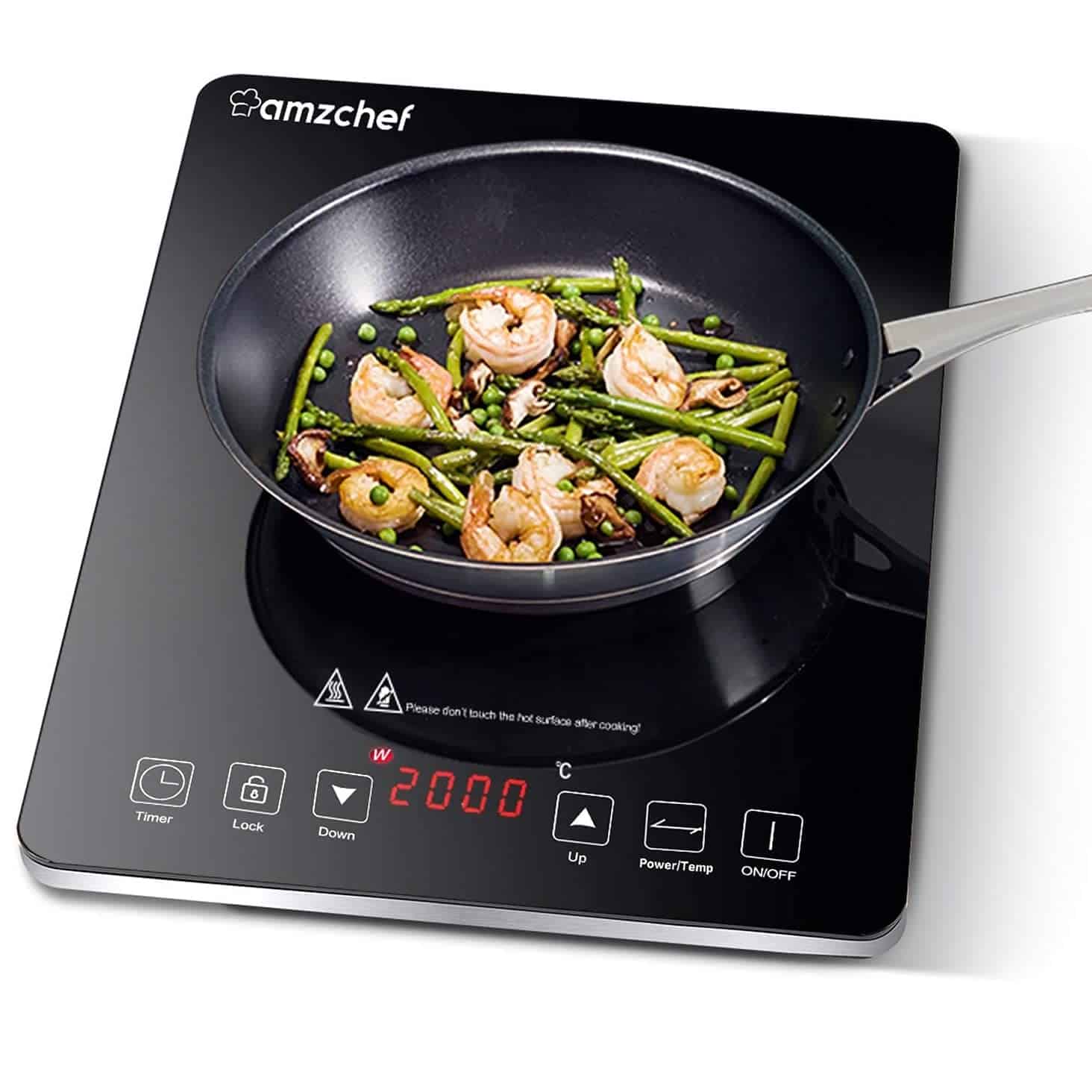
FOR: Van of All Sizes, for those who just need a fire
DIMENSIONS AVAILABLE: 1-2 Plates
POWER SUPPLY: 220V (Inverter or Column)
Slim, Stylish, Compact and Easy to Store, the Amzchef one-fire induction hotplate is an inexpensive, yet great quality product.
I bought one before I decided to install two burners instead of one in my van (to homologate the van in Germany, they asked for a built-in stove, later I found out that it was actually not necessary).
TECHNICAL FEATURES
- Slim, Elegant, Compact and Easy to Store
- Power: 300-2000Watts
- Adjustable Timer and Intuitive Control Panel
- Glossy Black Crystal Wear Resistant and Easy to Clean
- Integrated Auto-Shutdown
5.2 ISEASY INDUCTION PLATE
BEST BUILT-IN INDUCTION
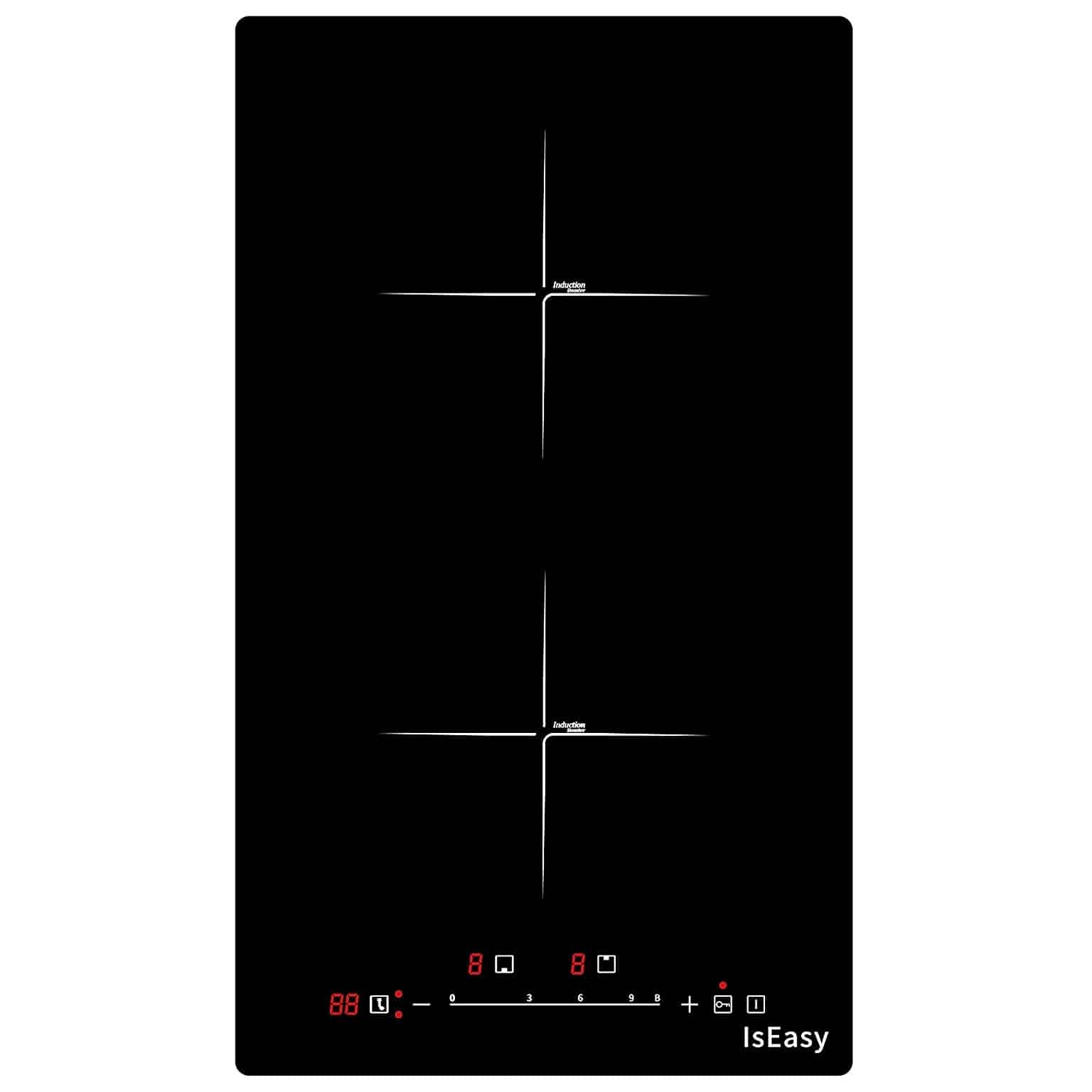
OVEN FOR: Stationary Outfitters with Large Electrical System
DIMENSIONS AVAILABLE: 1-2-3-4-5 Plates.
POWER SUPPLY: 220V (Inverter or Column)
Stylish, relatively inexpensive and functional plate. This isthe plate I installed on my VW Crafter: I chose it mainly because it is among the least energy-consuming built-in plates I could find.
The truth is that, for induction cooking you hardly use more than 1000-1200 watts (it is also not good for batteries), so the less powerful a hob the better (under 2000Watts you can find only countertops and one-fire stoves).
TECHNICAL FEATURES
- 2 Burners with Maximum Combined Power of 3400Watts
- 9 Power Levels
- Integrated Overheating Protection
- Automatic Shutdown in Absence of Pan
6. The Fridge and Freezer in the Camper.
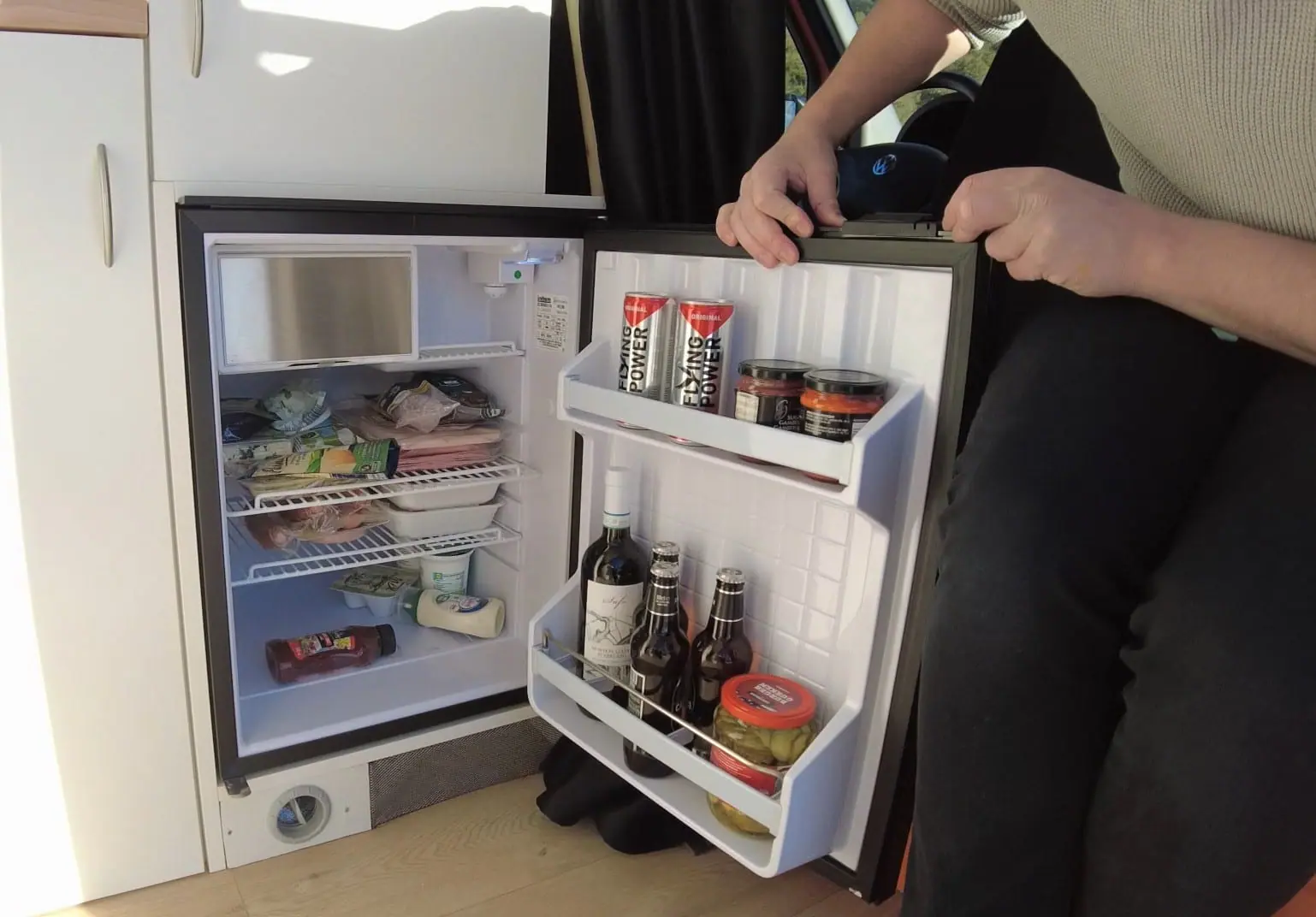
The Fridge is one of those accessories that more than many others helps to turn your RV/Van into a real home on wheels and definitely, one of those accessories that cannot be missing in properly-built campervan.
To help you choose the right refrigerator for your RV’s kitchen, I have written an in-depth article dedicated to this topic that I recommend you read:
READ MORE
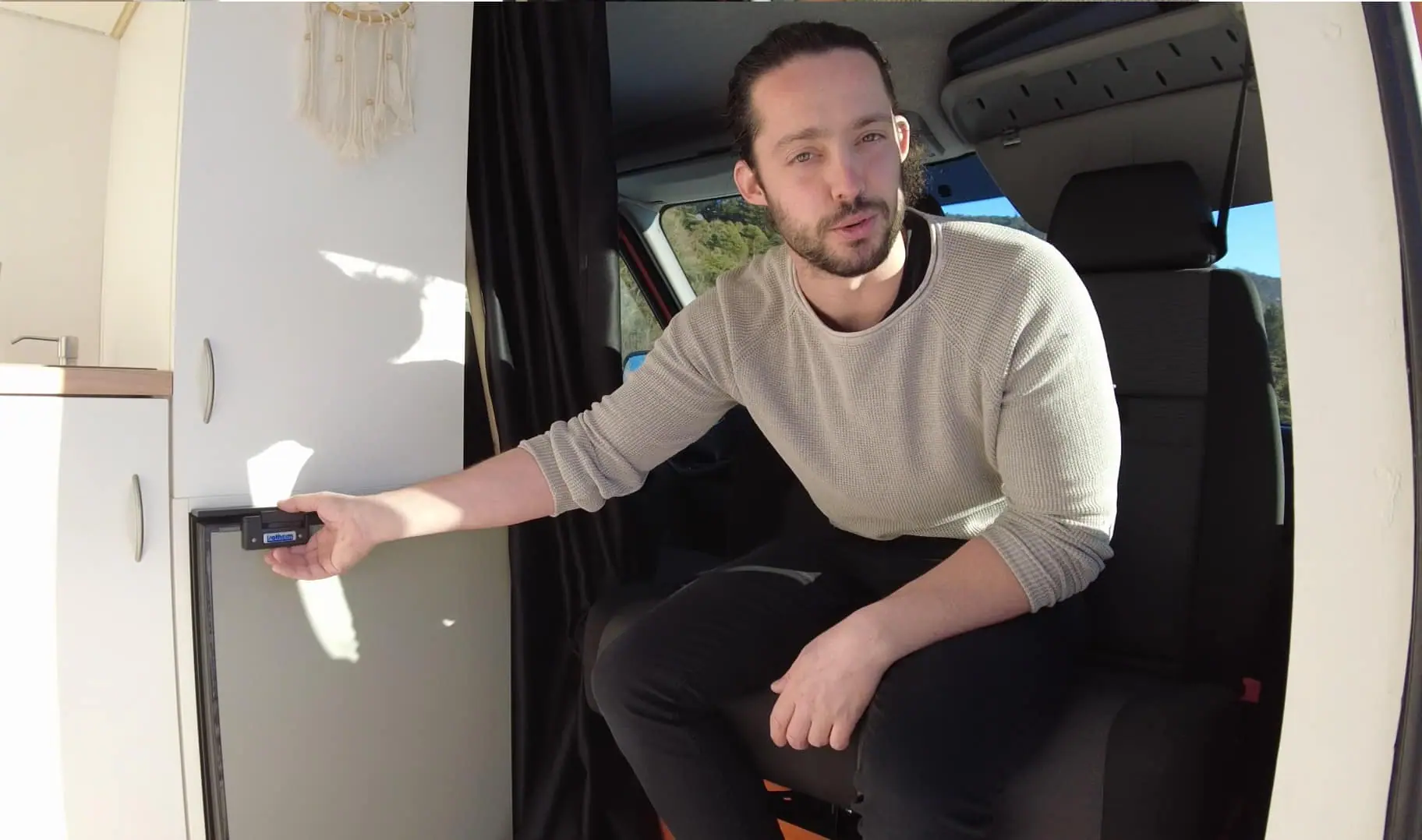
IL MIGLIOR FRIGO PER IL TUO FURGONE CAMPERIZZATO: QUALE SCEGLIERE?
Acquistare un frigo per camper trivalente o a compressore? Frigo Orizzontale o verticale? Frigorifero a 12V o 220V? Scopri tutto ciò che serve sapere, sui frigoriferi per camper!
The fridge is undoubtedly the most important accessory of any well-made camper: having cold beer wherever you are is a comfort that is truly priceless!😉
In this in-depth study, I explain in detail how the different types of refrigerators for motorhomes work (trivalent, thermoelectric, compressor, etc.), what to look for when buying and what brands to look for.
Article Index
2. Vertical or Horizontal Fridge?
3. What size is right for the refrigerator of your Van?
4. Which one to choose? The Best Refrigerators for Vanlife
7. Ovens
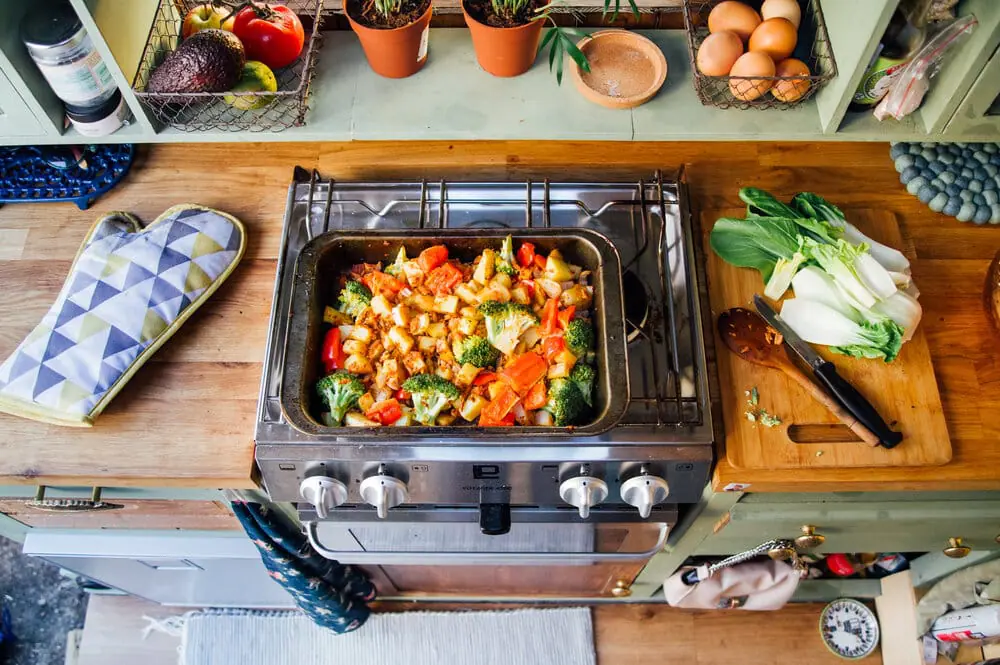
Once you have chosen the essentials (stove and refrigerator), you can think about the optional appliances.
Depending on the space available in your vehicle, your budget, and your preferences, you may want to include some of these comfort extras in your design, or skip them and cross them out directly.
An oven or electric stove, certainly fall into the category of optional accessories: you can live without them, but having them opens up different cooking possibilities (grilling, boiling, gratin, etc.). Of course, to install them inside your vehicle, you need to compromise space that could be used in other ways.
Below, you will find the best models of gas ovens and electric cookers for campers:
RV OVENS
Kitchen Oven “Vulcan”

Budget Option
Space-saving combination of a 2-burner stove and a gas oven, at a very affordable price.
- Spacious Oven (24Lt)
- 2-Burner Cooker
- Unique Cylinder Coupling
- Dimensions (40 x 54 x 45 cm)
- Maximum Power 800Wat
Dometic R31
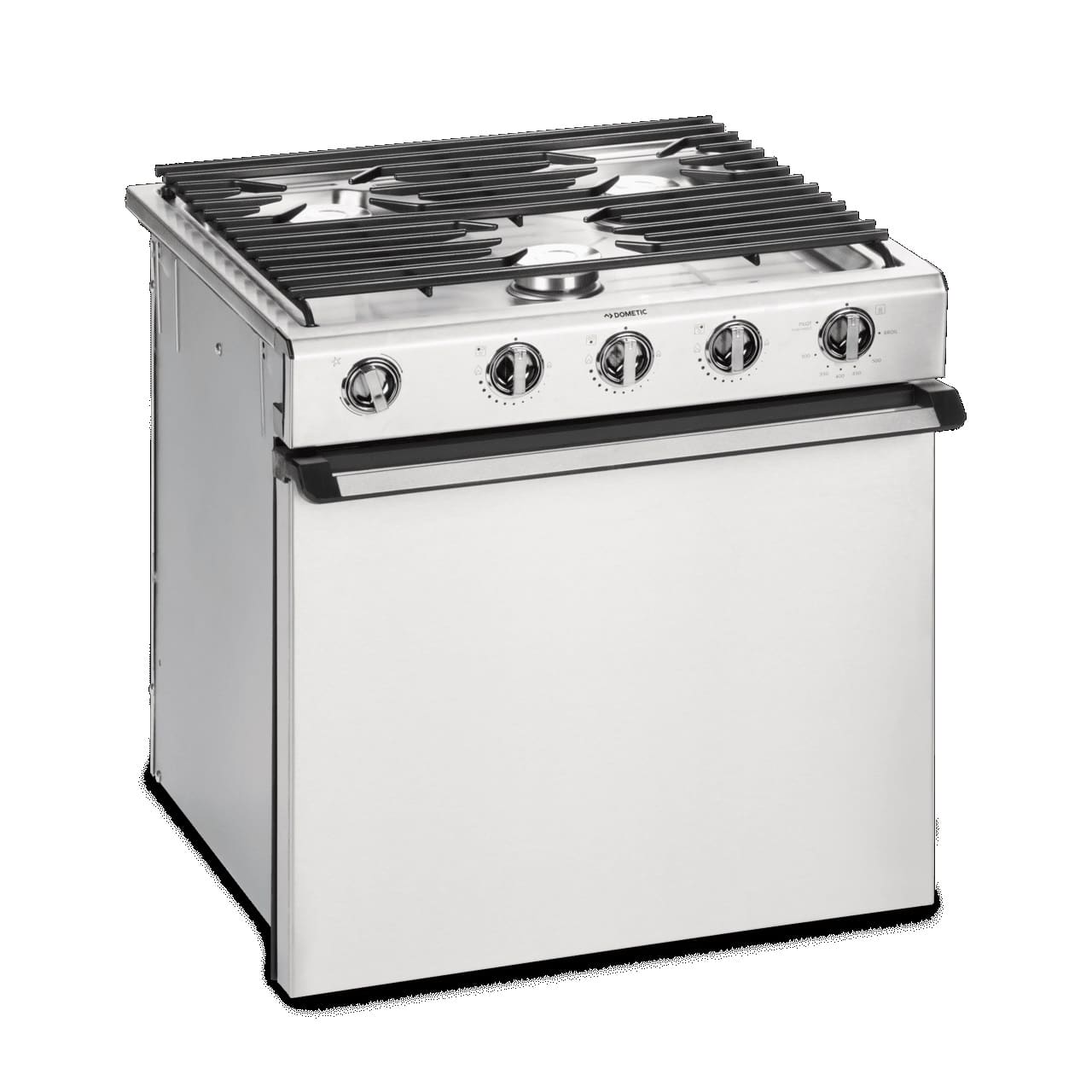
Standard Option
A name, a guarantee. This Dometic built-in oven with 3-burner stove is ideal for those looking for an elegant option.
- Spacious Capacity (24L)
- Dimensions 51 x 40 x 51cm)
- Great energy efficiency
- Unique Cylinder Coupling
Thetford Triplex
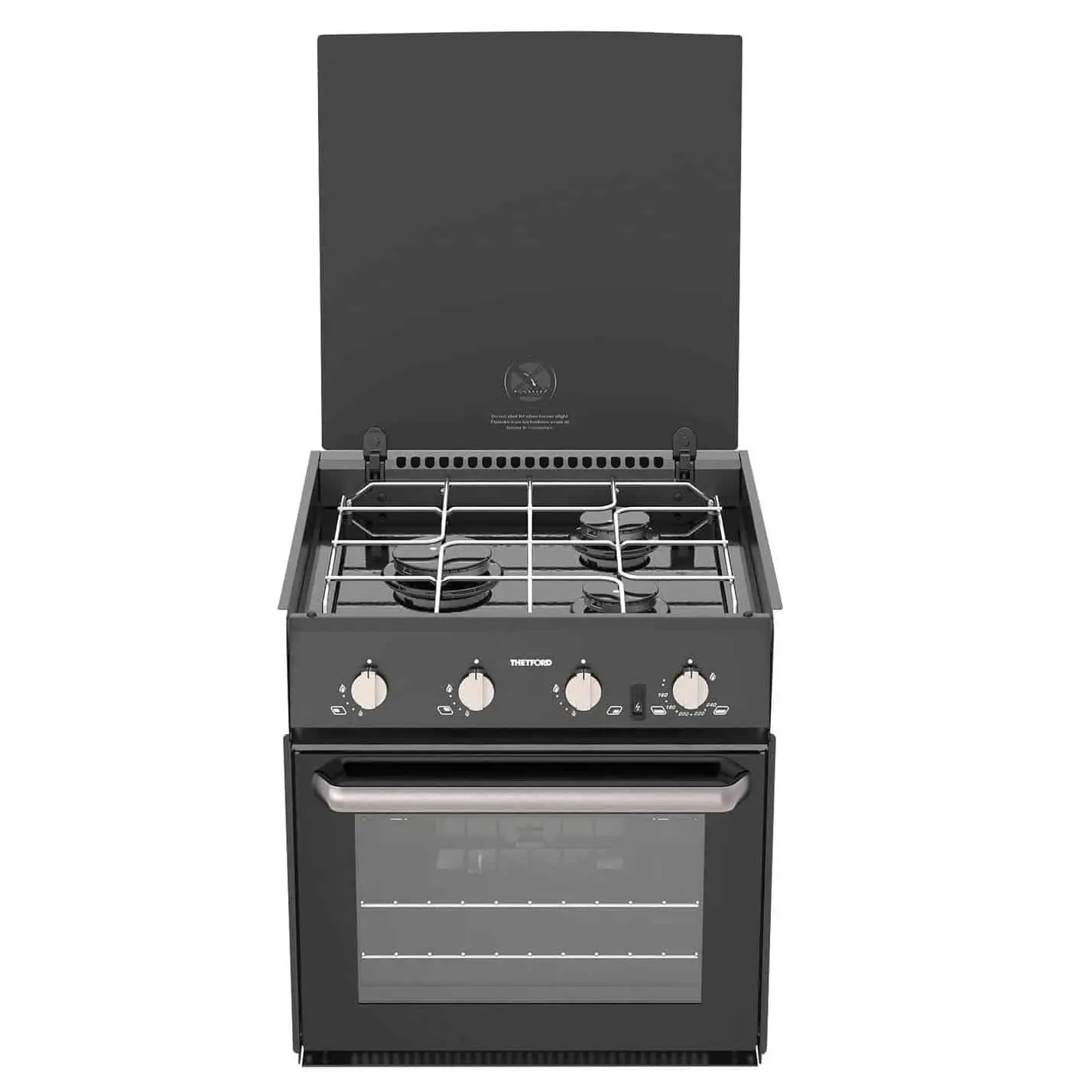
Premium Option
Grill, stove and oven in an attractively designed and Thetford signature all-in-one appliance.
- Modern and Quality Design
- Compact (46x 44x 49cm)
- Capacity of 36L
- Maximum consumption 547g/
ELECTRIC COOKERS FOR CAMPERS
Tristar Ventilated Oven 19L
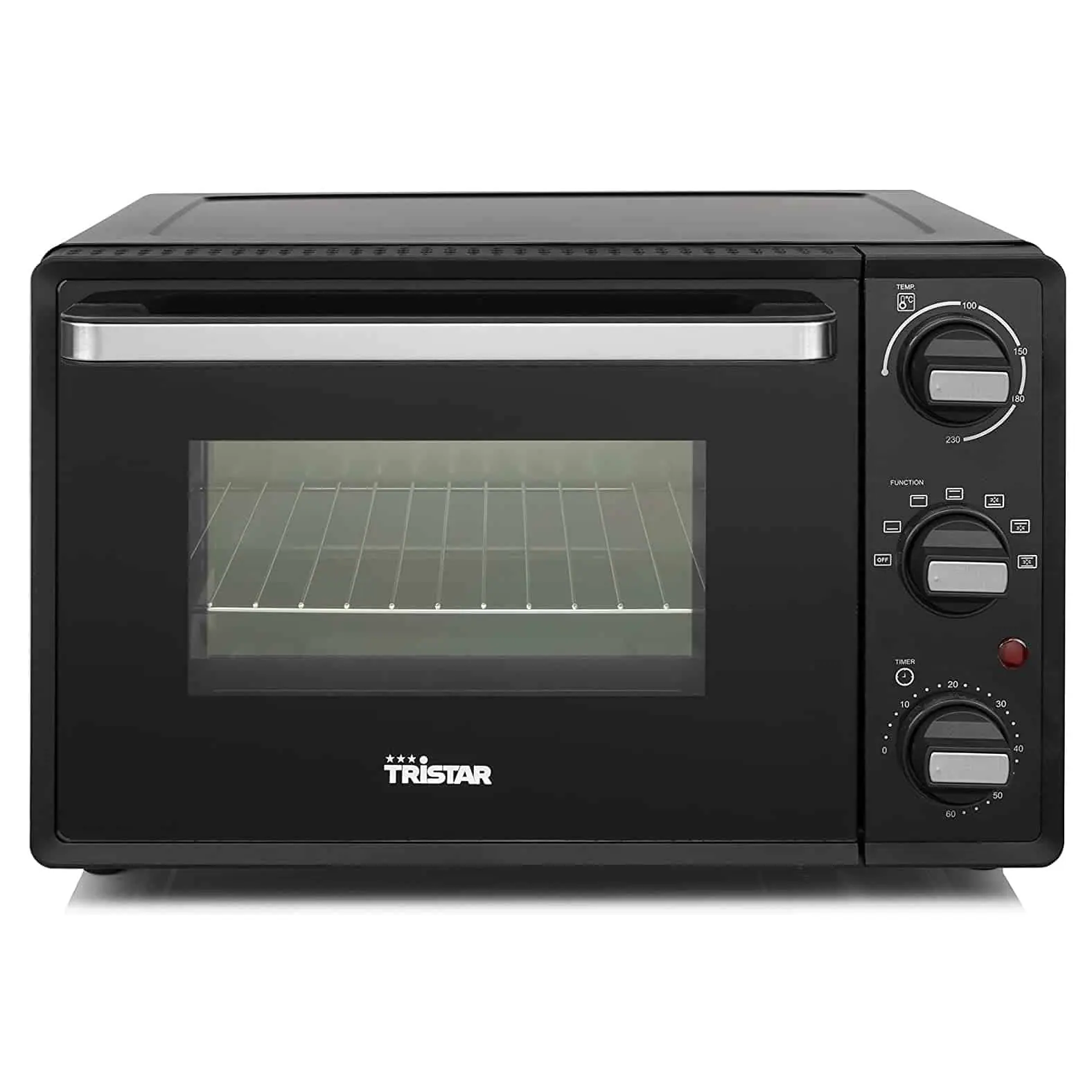
Best Option Under 1000Watts
A small 800Watt kind oven on batteries, ideal for toasting, heating or gratinating food for two people.
- Cost Contained and with Good Capacity
- Compact (28 x 43.7 x 44.2 cm)
- Maximum Power 800Watt
- Adjustable temperature between 90°-230°C
- Also available in 60L version for families
DeLonghi MIDI 24L Oven
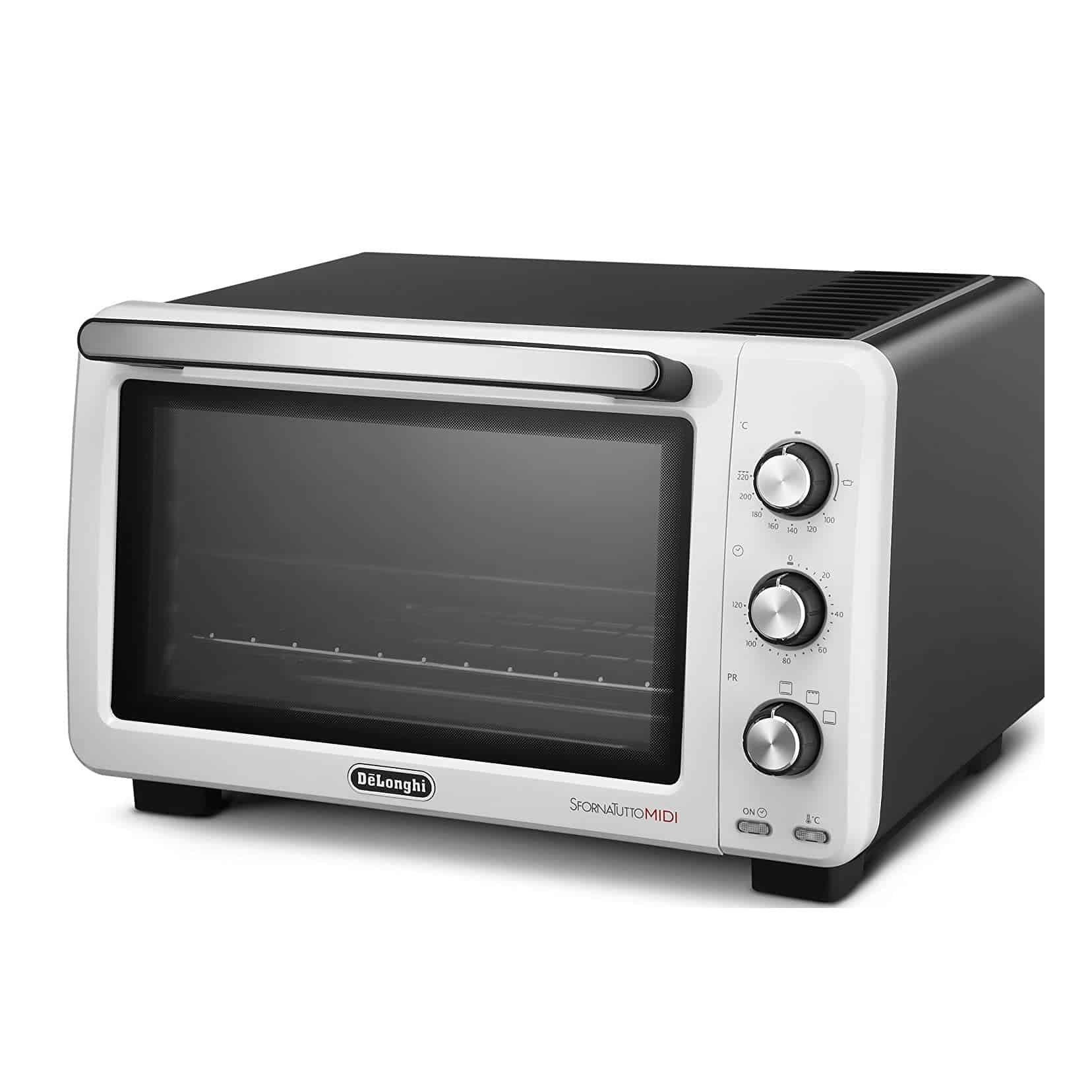
Standard Option
The DeLonghi Sfornatutto is a fast, quality electric oven that can still be powered by a 2000Watt inverter.
- Spacious Capacity (24L)
- Compact (28 x 43.7 x 44.2 cm)
- Maximum Power 1800Watt
- Adjustable temperature between 90°-220°C
- Grill function
- Grill, Leccarda and Tray Included
DeLonghi Oven MAXI 32L
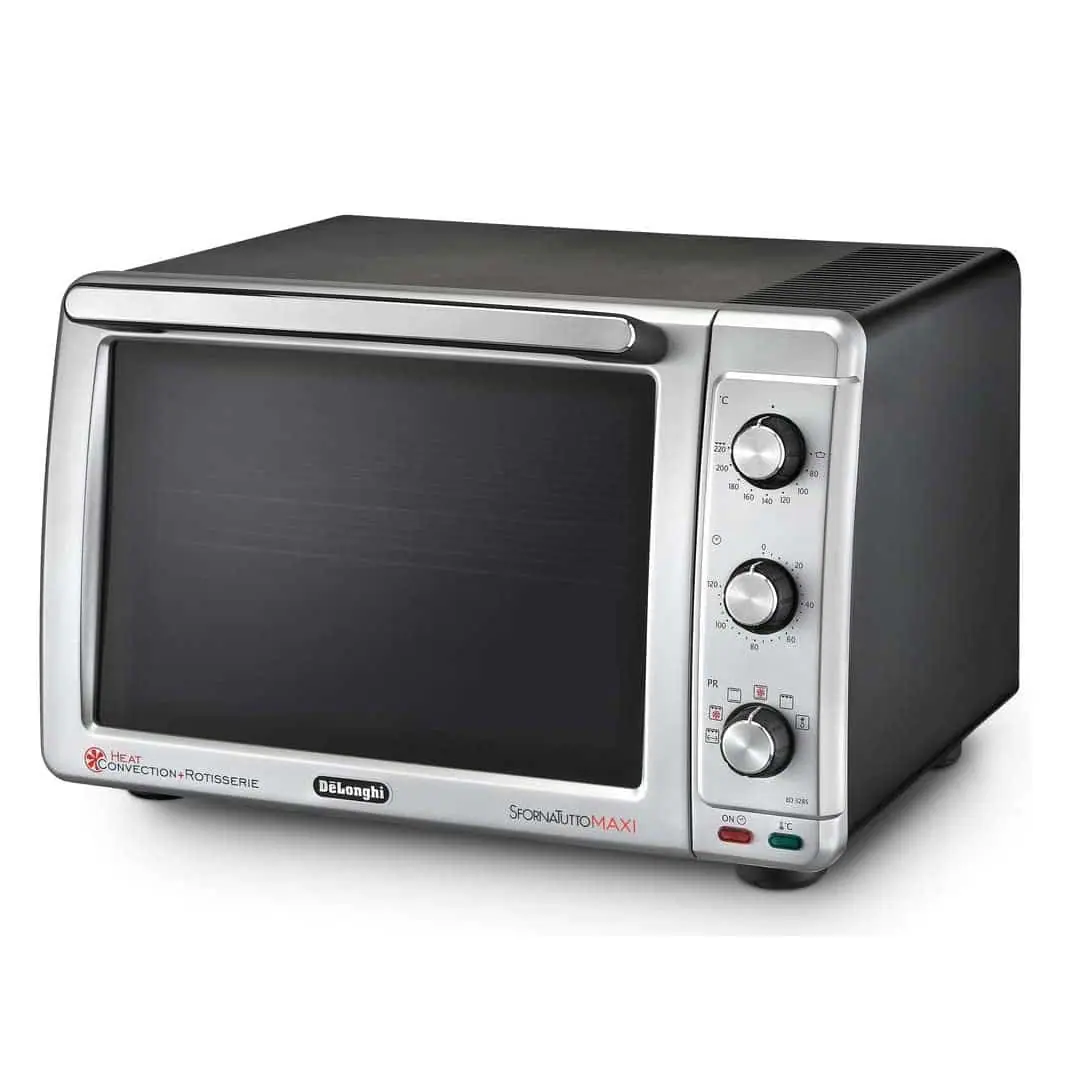
Option for Families and Food Lovers
Larger capacity oven for more complex preparations or larger groups
- Ideal for Families
- 6 Cooking Functions
- It Esily Fits 2 Frozen Pizzas at a Time
- Maximum Power 2200Watt
- Adjustable temperature between 90°-220°C
- 2 Grills and Leccarda Included
8. Microwave, Micro-Oven and Kettle
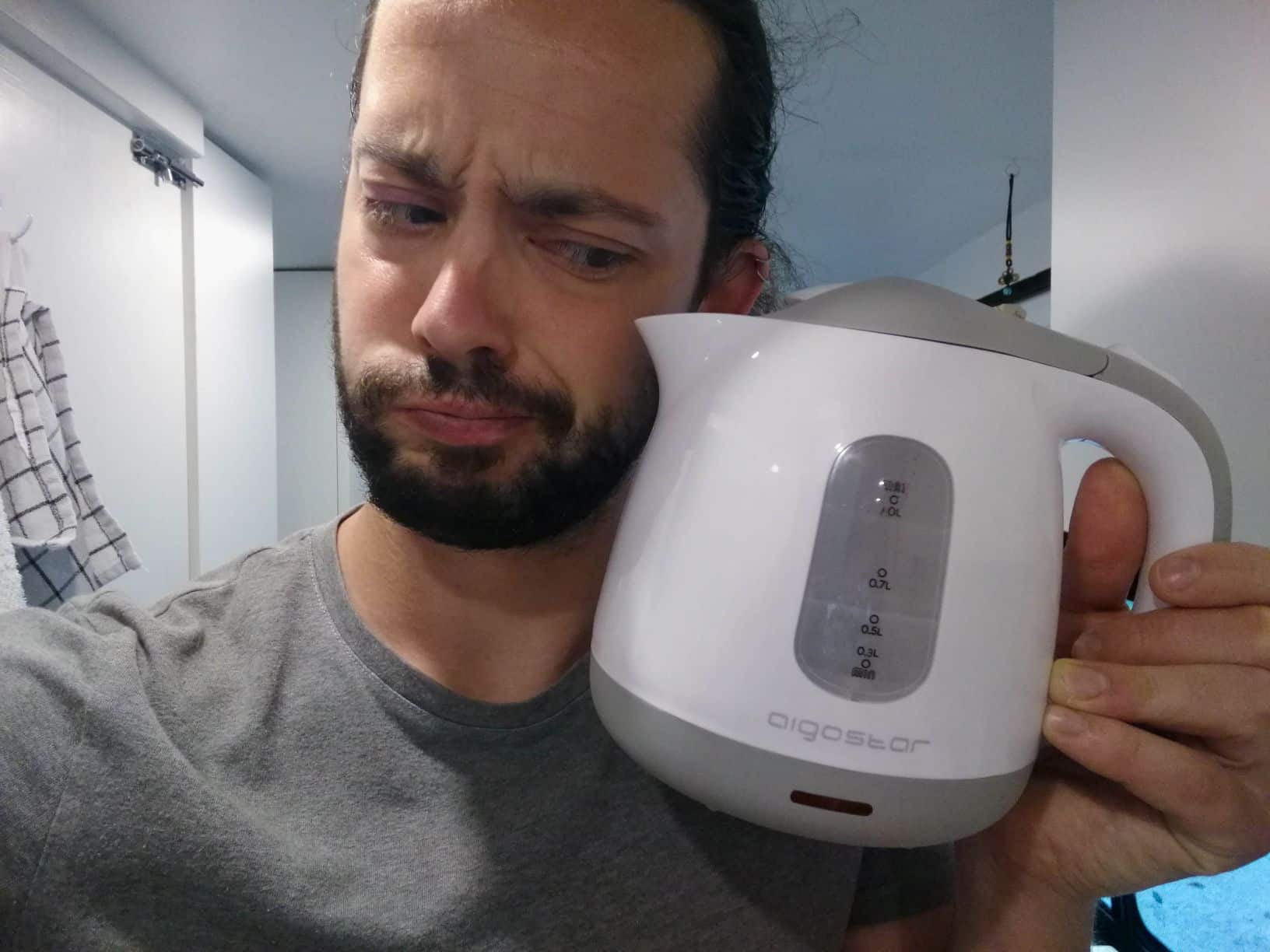
In addition to ovens, other smaller RV/Van appliance options may include microwaves, micro ovens, or kettles.
Each of these devices certainly can be useful in saving us time and labor in preparing our on-the-road meals.
Having said that, however, it is important to note that since electricity is a scarce commodity on an RV (and not infinite as it is at home!), it is important in case you want to include these types of appliances in your design, Choose energy-efficient models with as low a power rating (in watts) as possible.
By doing so, you will subject your batteries to less stress and be able to use your devices longer.
Of course, this argument does not apply if you plan to cook regularly attached to the grid (in this case, you can choose the apparatuses you like best, not caring about their consumption 😉 ).
Below, find examples of kitchen appliances suitable for a van or RV (low power rating) with a standard electrical system (with an Inverter of at least 1000-1500Watts):
SECONDARY APPLIANCES FOR AN RV KITCHEN
Phillips 830W Toaster

Candy Microwave 800W
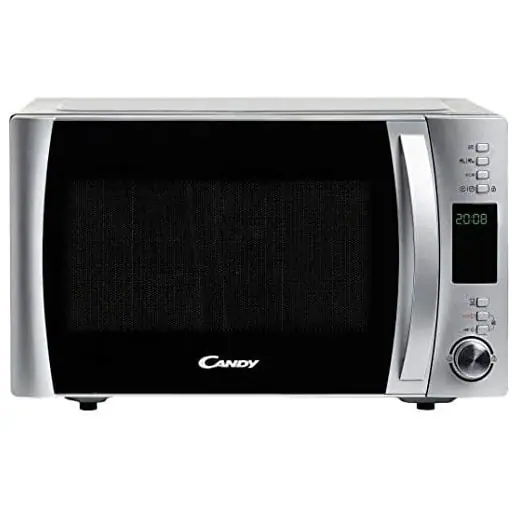
Aigostar 1100W Kettle
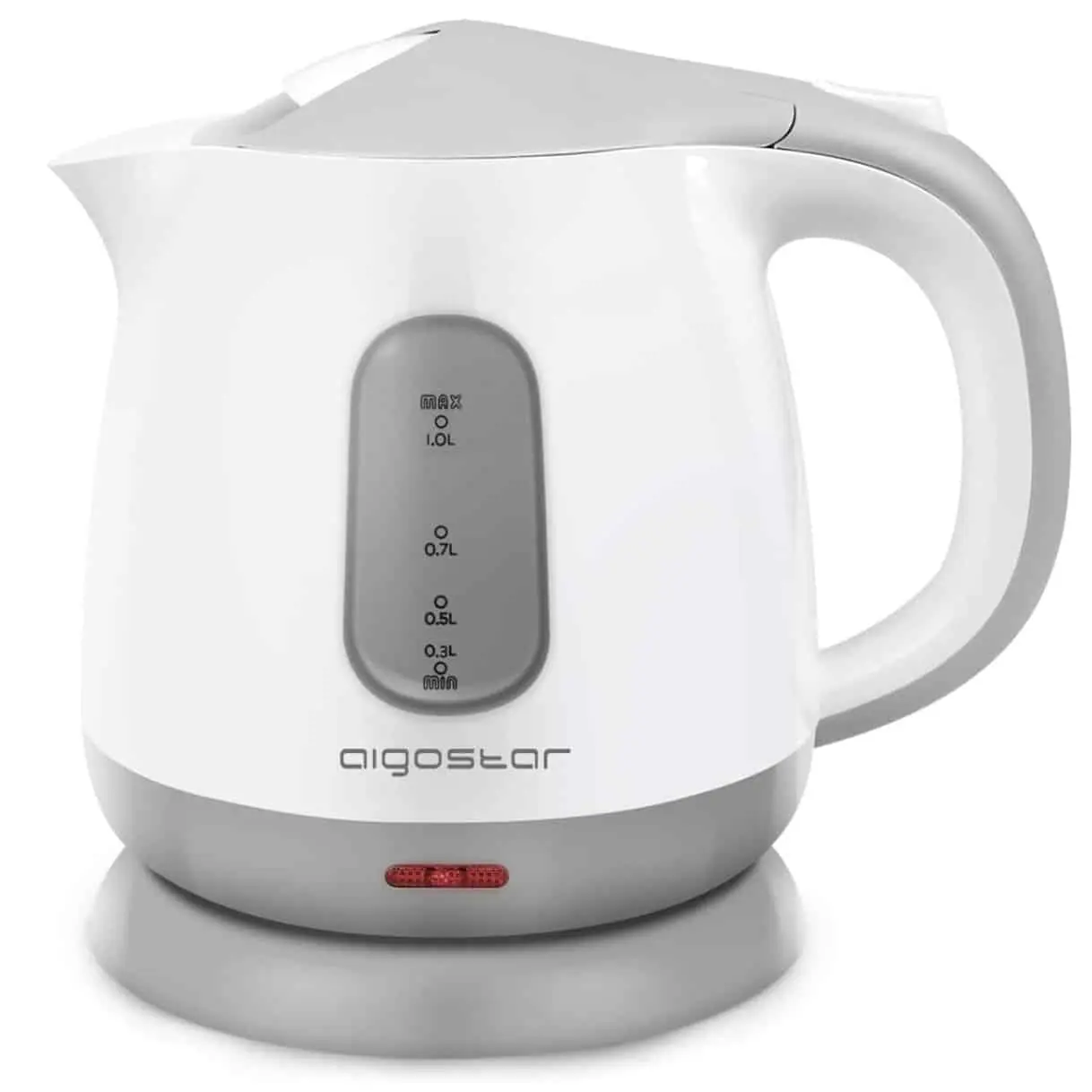
9. The Sink
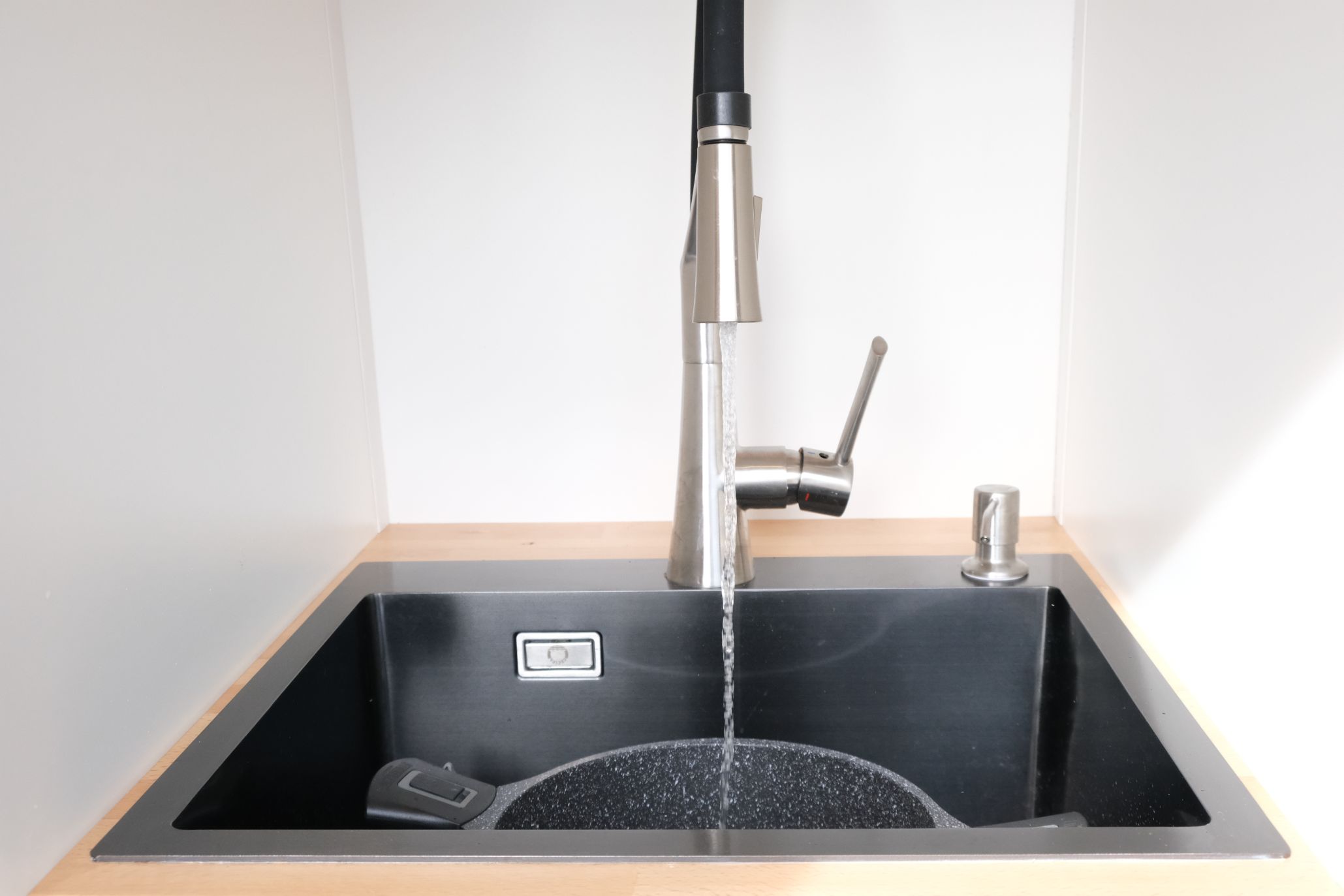
If there is one thing you can be sure you will use every day, many times a day, it is the sink!
The sink in the van is used for washing up, preparing food, making coffee, washing dishes, and leaving behind things you don’t feel like washing at the moment 😉 In short, it is one of the essential components of an Campervan’s water system!
If you are interested in finding out all the components of a van’s water system and how to connect them together, I recommend the Do-It-Yourself Van Water System Guide – With Diagram 🙂
In addition to a practical accessory, the sink is also a furniture component, always in sight.
For all these reasons, it is important to choose the right sink for your needs, spacious enough to allow you to work with ease, but at the same time not too bulky to consume too much valuable space.
Lastly, the choice of sink is also a matter of style, so it is very subjective and personal: depending on the feeling you want to give your van, you could go for different materials and different shapes.
9.1 CHOOSE THE SINK
Below, I leave you with a list of 5 types of RV sinks (completely different from each other) that might inspire you to choose the right one for you:
- Deante – Techno Satin Sink: extremely compact stainless steel space-saving sink (38x38x15cm, with 28x28cm bowl). This sink is one of the smallest on the market, and is suitable for camper vans of small size where space is really vital.
- Dometic – Sink with Faucet and Glass Lid.– Another space-saving sink that can be closed and turned into a countertop if needed. Size 40x42cm.
- Dometic – Sink with Integrated Cooktop and Glass Lid– An upgrade from the previous model where in addition to the sink and glass lid, we also find a two-burner (gas) stove, all enclosed in the 60x45cm area
- Cecipa – XL Recessed Sink with Soap Holder. – If you want to break away from classic RV designs (which are often really aesthetically hideous), the options are really endless. This is the sink I installed on my camper van: a really big and spacious (45x50x35cm) black stainless steel, flush-mounted sink. Personally, I find these types of sinks more practical and aesthetically much more pleasing than their predecessors; of course, space is needed to install them (it is not a space saver like previous models).
- ECD – Countertop Sink– The sink does not have to be recessed into a cabinet, but can also simply be fixed on it. Countertop sinks are a type of sink with a contemporary and modern design, and it is no longer as uncommon as it once was to see them installed even in DIY camper vans.
9.2 CHOOSE THE TAP
Once you have chosen the sink you like best, it will be time to choose a faucet (assuming this is not already included with the sink-most often it is not).
In choosing a kitchen faucet for your RV, I recommend that you ask yourself the following questions:
- Is it compatible with your chosen sink? If it is not, already you can discard it and look elsewhere.
- Is it solid and easy to clean? Aesthetics are important, but the quality of materials in the long run is much more so.
- Can it be firmly fixed so as to resist vibration? You don’t want to install anything too fragile.
- Is it easy to install? If a faucet is sold already with the entire installation kit, it probably is.
- Is the water jet easily adjustable? To avoid wasting water, I recommend a faucet with a mixer.
That being said, the world is full of faucets: there are all shapes and sizes of them. Below I leave you with only 3 types of example faucets, which I personally find particularly functional and aesthetic fora Do-It-Yourself camper, and which I might recommend:
Faucet with 360° Swivel Shower
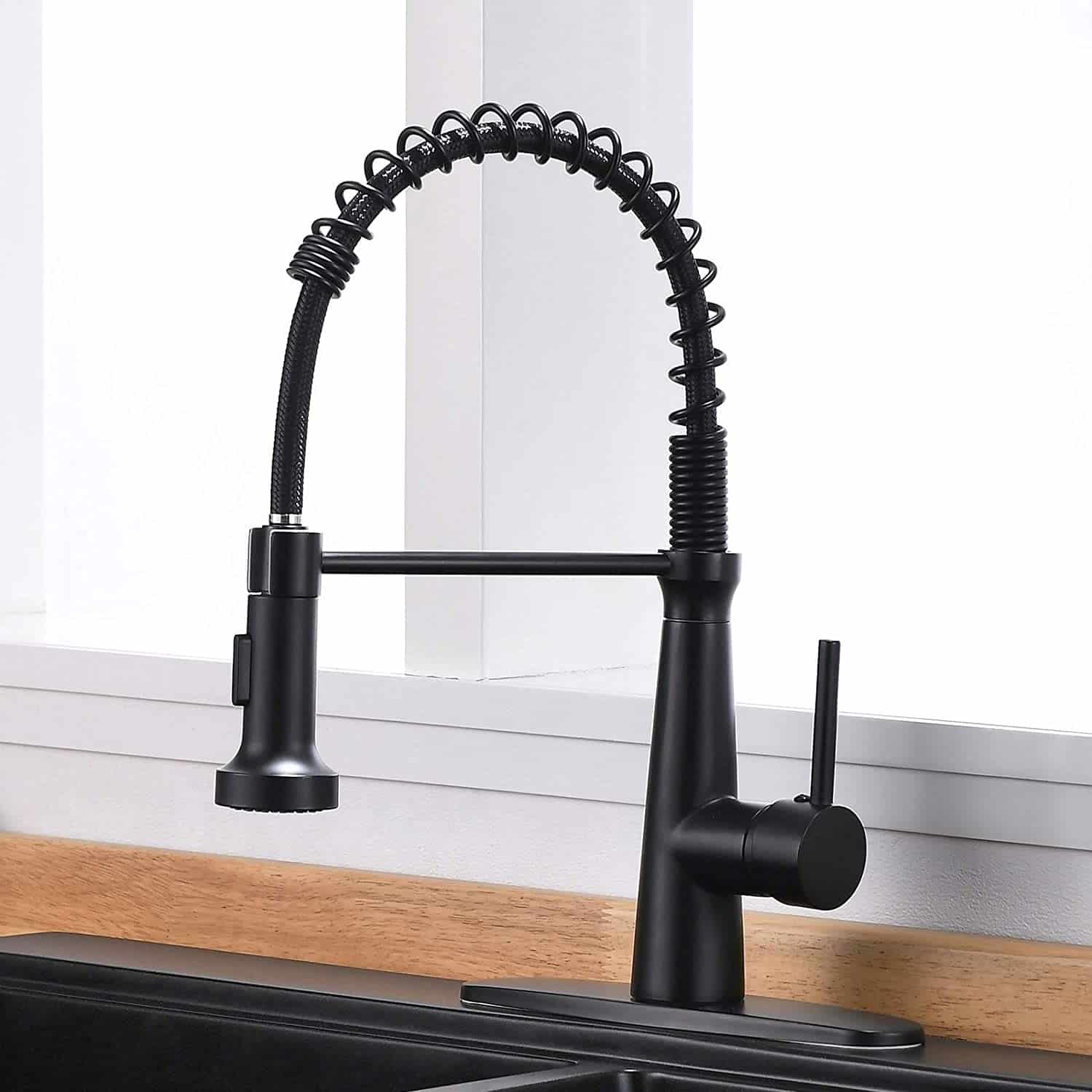
Tall, convenient faucet for washing and rinsing anything (I installed a similar one on my van).
Faucet with Pull-Out Shower
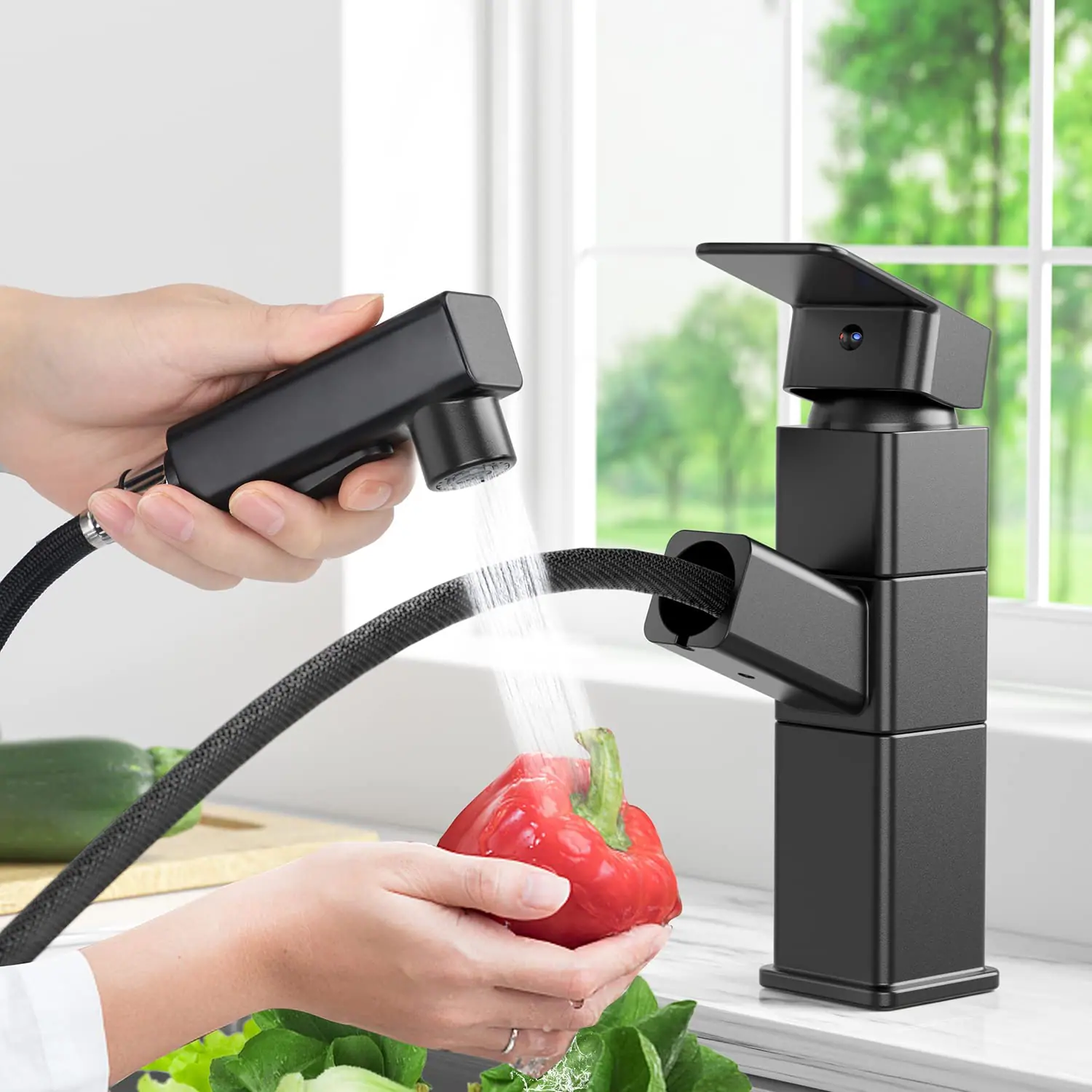
Pull-out faucet for better washing. There are vanlifers who also use such a faucet for showering as 2in1 😉
12V One-Way Revolving Faucet
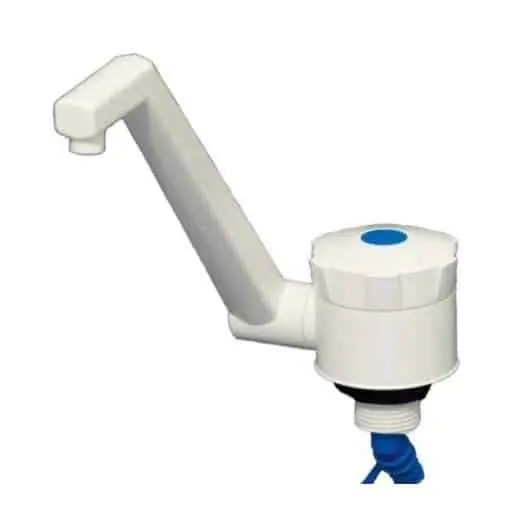
A brazen-free, inexpensive and functional 12V faucet suitable for small sinks fed by a removable clear water tank.
10. The Kitchen Furniture
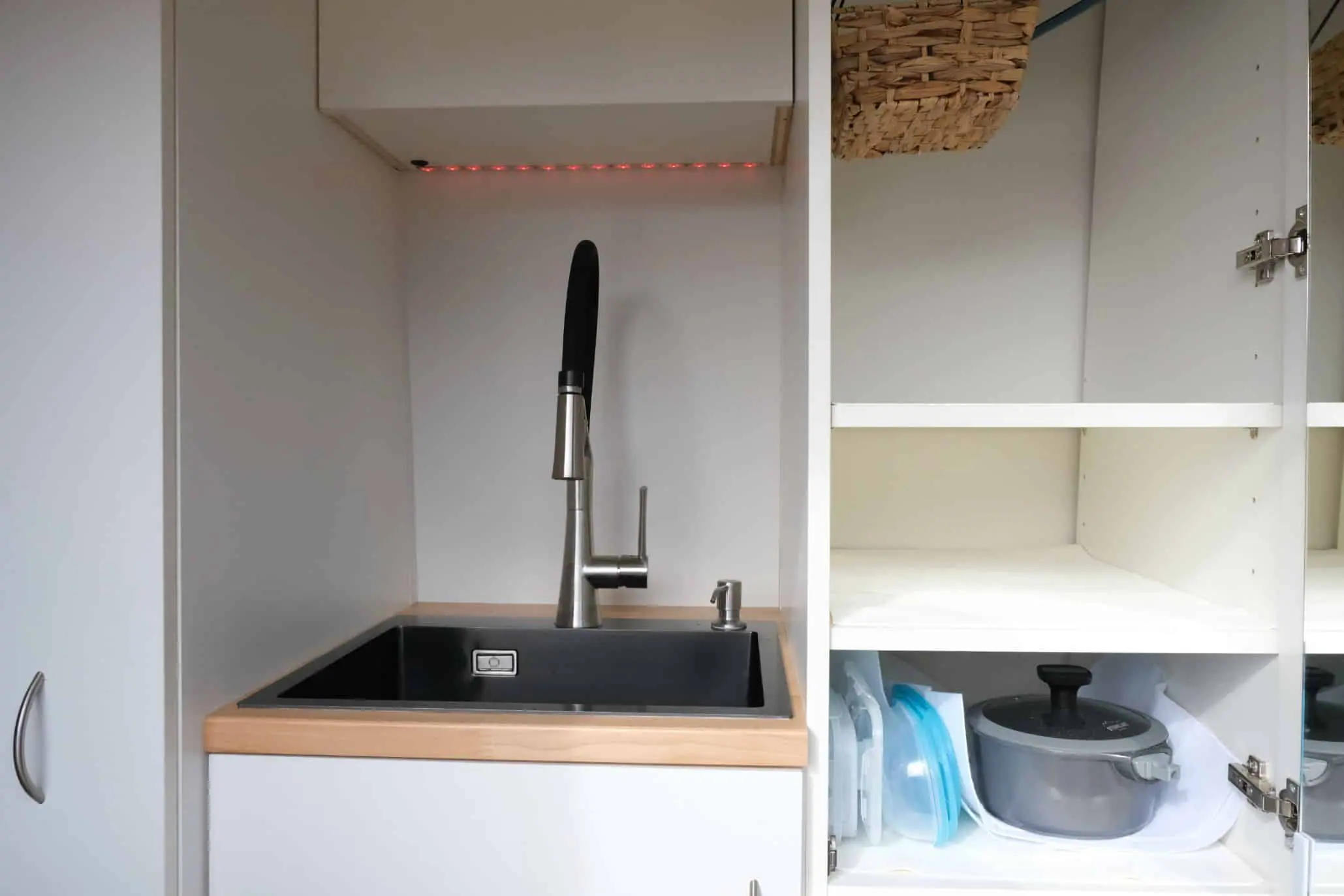
Once you have chosen everything you want to include in your RV/Campervan kitchen, it is finally time to design all the cabinets and turn the project into reality.
To do this, there are various solutions, suitable for everyone (depending on your time and budget): there are those who buy ready-made furniture, those who repurpose it, those who commission custom-made furniture, and those who create it from scratch (like us).
Since each project is different both in terms of materials and style, I thought below I would simply show you what I used to build my kitchen so that you can help you study how to put yours together.
10.1 WHAT I USED TO BUILD MY DIY CAMPER’S KITCHEN
As materials to create our kitchen we used:
- 1.9cm white melamine-faced wood panels for cabinet walls: Melamine-faced wood is one of the least expensive plywoods on the market and is what home kitchens are commonly constructed from. Simply put, it is a chipboard wood coated on the edges with some synthetic material and a special resin (melamine) that makes it waterproof and easy to clean. Once we had drawn the entire kitchen with a 3D modeling program (Rhino) and took the curvatures of the walls with cardboard templates, we had custom panels cut and ennobled by a local carpenter and assembled them on site.
- Worktops (and table) made of 3.5cm Laminated Wood: Laminated wood is wood composed of several wooden planks (lamellas) pressed and glued together. Once treated, it becomes totally waterproof and gives a very “homey” and modern visual effect.
To bring it all together, we used as tools:
- Wood glue
- Drill Driver with Hinge Cutter
- Wood screws
While as other assembly components we used:
These are all the materials and accessories we used to build our kitchen cabinets. I hope this information will be helpful for you to create one that suits your needs and is tailored for you 🙂
In the next paragraph, to conclude, I want to show you instead all the extra equipment we use for cooking.
11. Equipment for Cooking in the Camper
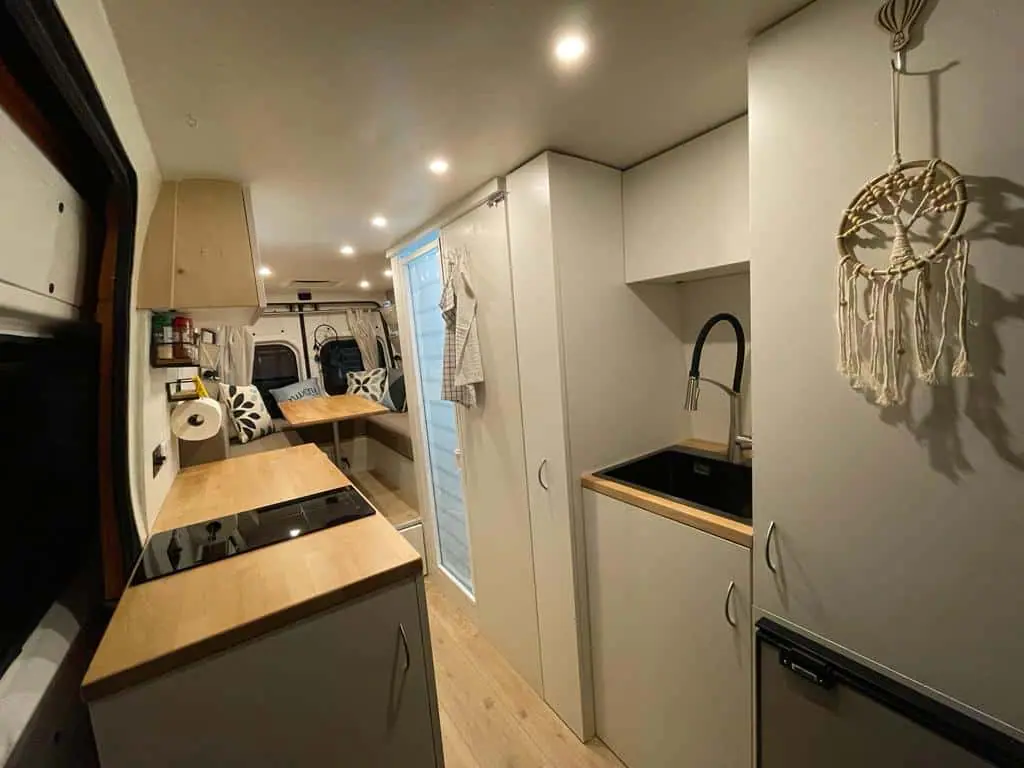
As a final point, I want to show you some accessories and tools you might need to complete your kitchen on wheels that I personally found very useful.
As with most components of a camper van, when choosing accessories, it is advisable to favor space-saving solutions: in the end, any space saved is extra space you can use for other things! 🙂
Recommended Camper Kitchen Accessories:
12. Conclusion
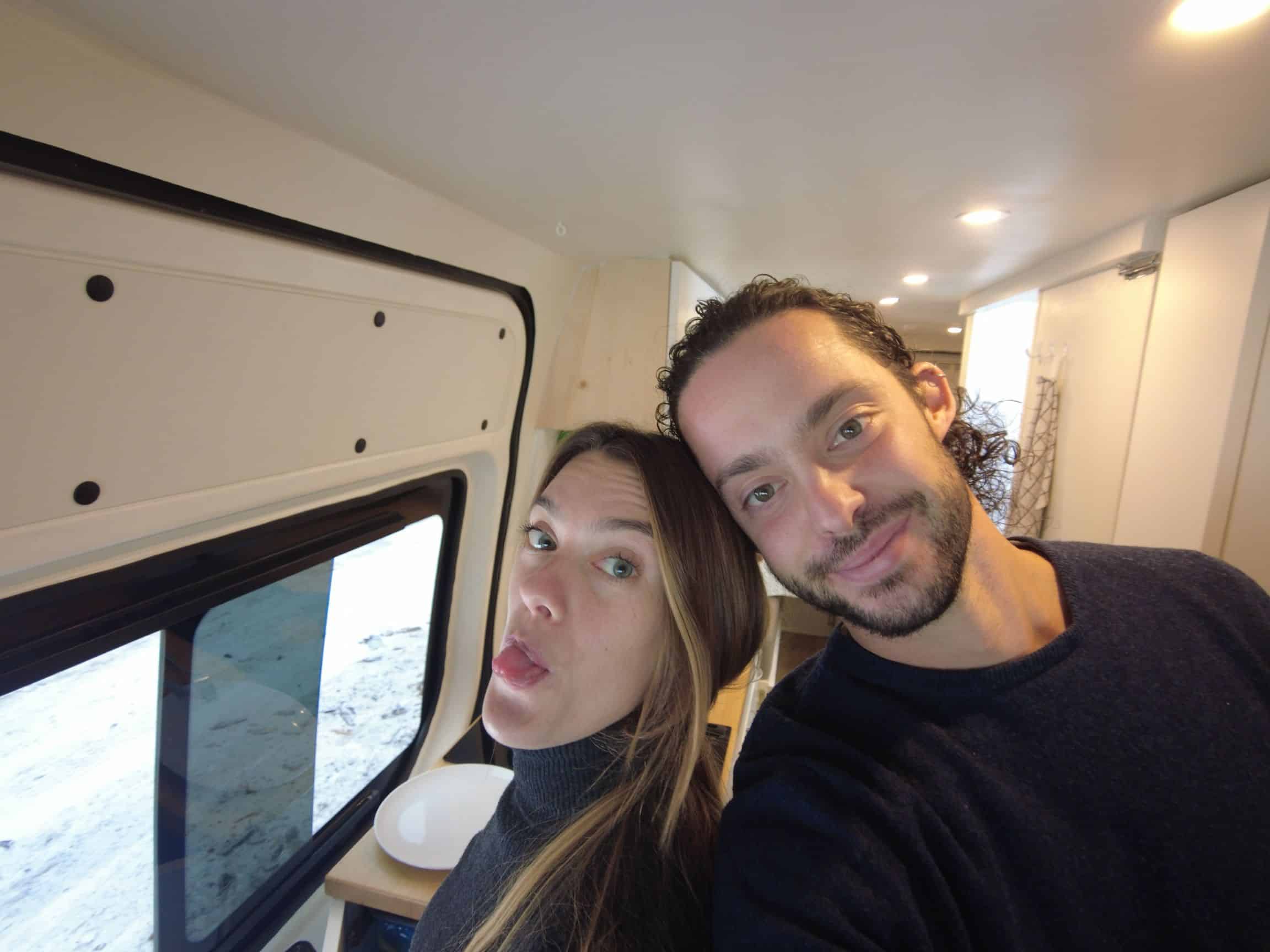
And here we come to the end of this Guide on Kitchen Ideas for your DIY Campervan Conversion.
I really hope all the ideas in this article will help you bring your own unique and very personal kitchen on wheels to life!
As always, if you have any doubts, questions, need clarification, think something is missing or if you noticed any inaccuracy in the article (that can always escape! heheh), feel free to write me in the comments below and I will try to help you as much as I can 🙂
Also, don’t forget to check out the article 15 Essential Tips for Cooking in the Van where you’ll find many useful tips for using your RV’s kitchen to the fullest ;D
Thanks for Reading, and see you in the more insights! 😉
BEFORE YOU GO, CAN I ASK YOU FOR SOME FEEDBACK?
Writing detailed articles like this takes a lot of time and effort..
If you liked it, can I ask you to leave me a feedback message in the comments at the bottom of the page?
For a content-creator, knowing that you are being read and that your efforts are useful to someone is the best motivation to keep writing and doing better 🙂
Let me know what you liked or what you think could be added.
If you’d like, you can also share the article to help other people find it!
Thanks for the help 🙂

Read the Van Conversion Guides
How to Calculate the Right Section of 12V Cables | EASY GUIDE
An undersized cable does not carry enough current. A cable that is too undersized can lead to a fire. An oversized cable, on the other hand, simply costs more and is a waste of money. Are you wondering what is the logicfor choosing one section of cable over...
Bluetti vs Ecoflow | Which is the Best Portable Power Station for RV/Vanlife?
The Portable Power Station is an increasingly used accessory on camper vans and RVs, but when does it really make sense to purchase and own or install one? In this article we try to shed some light on how these systems work, the best options on the market, and the...
Van Conversion DIY: How Much Does It Costs? | My Experience
How much does it cost an entirely DIY van to campervan conversion? The queen of all questions... In this article, I want to show you all the costs of my conversion from start to finish, so that you too can get an idea of what it might cost! ...
Van Electrical Diagrams for your DIY Project – Ready to Install
The Electrical System is often one of the most complicated steps in a DIY van conversion. How much energy is needed? What apparatus/devices to purchase? How to connect them? How much would it cost? These are all doubts and questions that normally everyone finds...
Van Interior Conversion: Best DIY Ideas for your Project!
The Interior Outfitting of a DIY converted van is both an aesthetic and structural choice. In this article, you will find useful information and inspiration ideas for customizing the Walls, the Ceiling, and the Floor of your Van! DIY CAMPERVAN SET-UP:...
The Best Fridge for Your Campervan – Which One to Choose?
Buying a trivalent or compressor RV refrigerator? Horizontal or vertical? 12V or 110/220V? In this article you will find all the information you need to choose the best fridge for Your Van, tailored to your Needs! 🙂 THE REFRIGERATOR IN THE VAN:...
Van Conversion: How to Build a DIY Bed for your Camper Van
A Camper is not a Camper if it does not have a bed. Where to Sleep and... Dream! In this Guide you can find the inspiration you need for creating a DIY Bed in Your Campervan, And I'll show you step by step how I built a Complete Bed/Dinette on my VW Crafter....
DIY Camper Bathroom: How to Self-Build a Toilet
If you are Campering a Van you surely must have wondered: How does the Bathroom in a Motorhome work? In this Guide I show you the various types of Bathrooms on the market, I explain how they work, and I show you how you can Build yourself an entirely...
Best 12V Fan for RV | DIY Installation Guide | Van Conversion
A Roof Fan helps keep your Vehicle's humidity under control and change stale air. In this guide you will find everything you need to know about mounting a Maxxfan Deluxe fan on the roof of YOUR van. ROOF FAN: WHAT IS IT FOR? Keeping an RV's...
How to Build a Shower in a Do-It-Yourself Camper
A Shower in the RV for some people is not necessary, for others it is a real necessity to be totally independent! In this guide I'll tell you how I built the shower of my converted van entirely Do-It-Yourself! INSTALLING A SHOWER IN A...
Complete Guide and Electrical Scheme for your D-I-Y Van Conversion
You dream of transforming your Campervan DIY and have never touched an electrical cable before? Or do you want to implement some changes to your Factory RV? In this guide you will find EVERYTHING (absolutely EVERYTHING!) you need to know to create the perfect DIY...
Converting a Van: How to Connect Electric Cables Without Mistaking
Want to know how to "connect" the electric cables in practice in a converted van? Stripping, Crimping, Wire Leads, Clamps, Tubing, Cable Ties and much more... You've come to the right place to learn All That! How to wire your van's electrical...

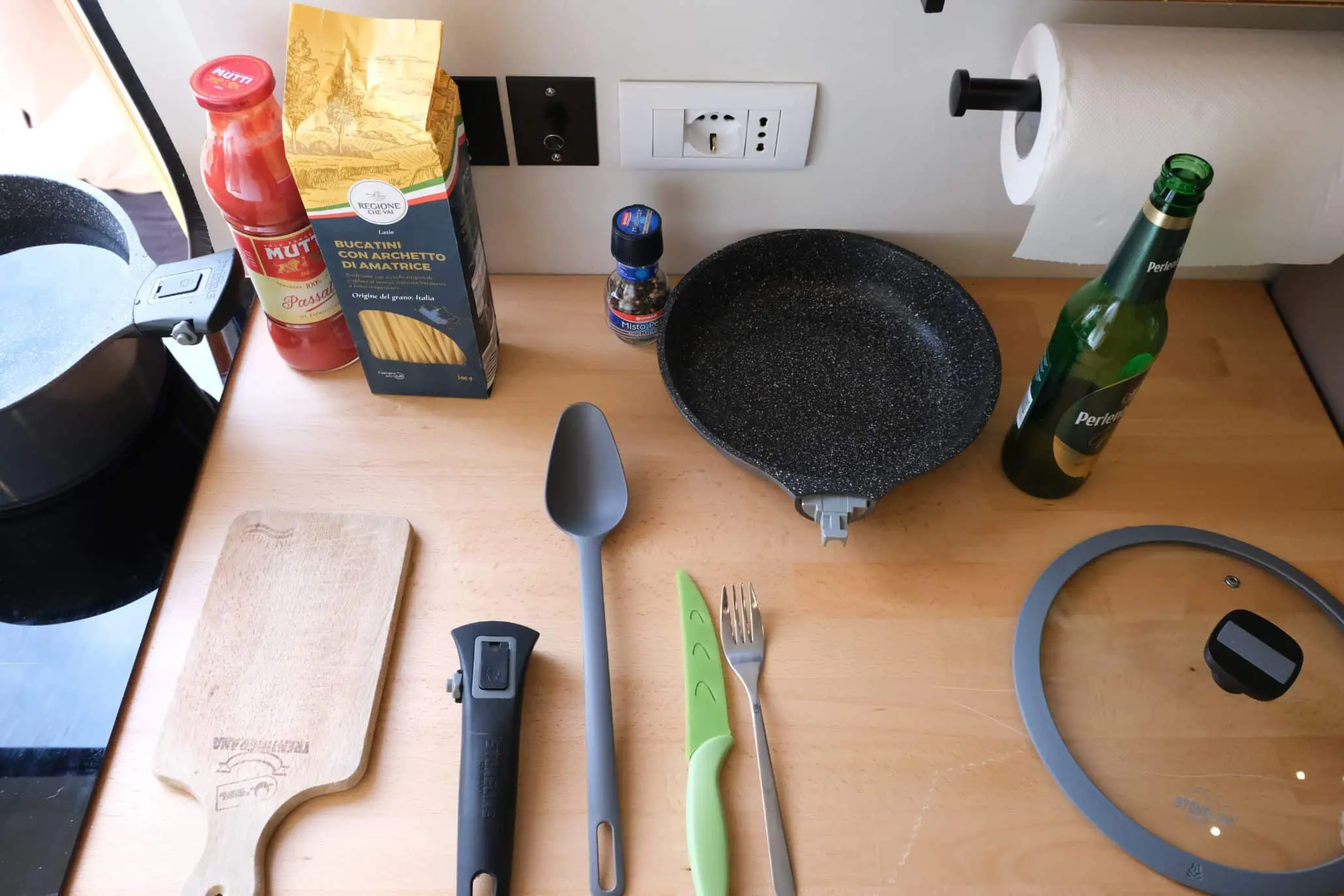
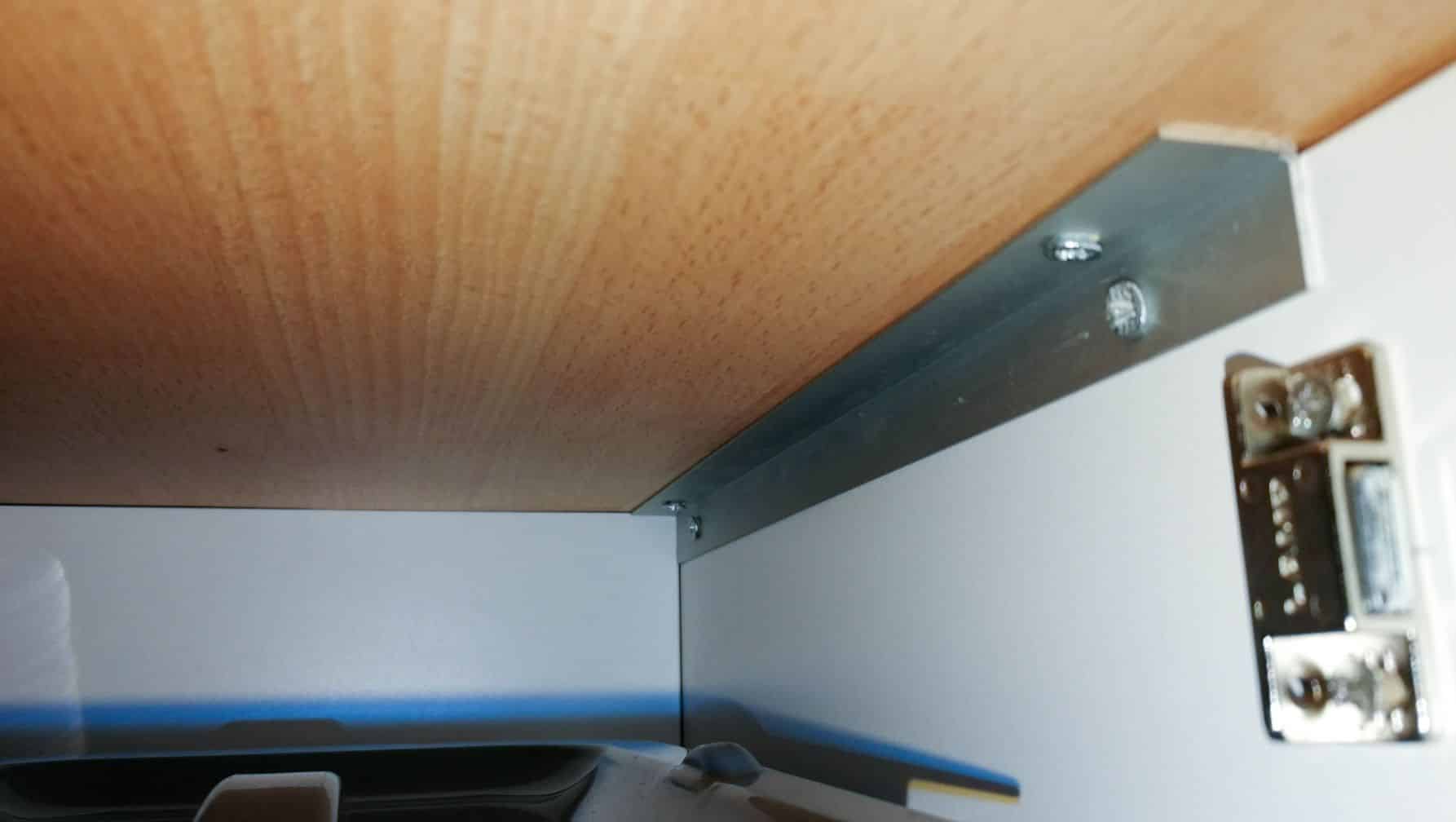

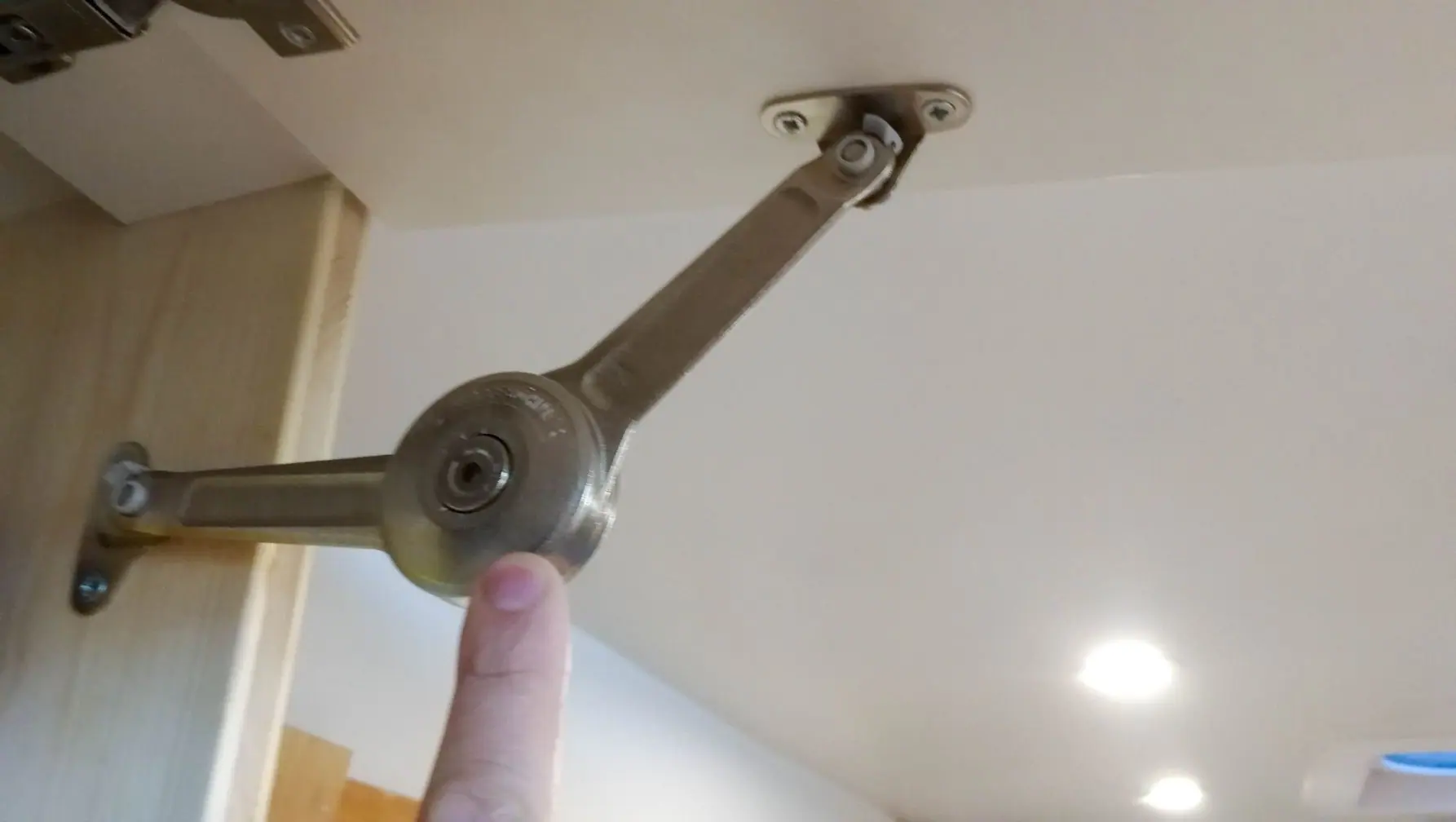

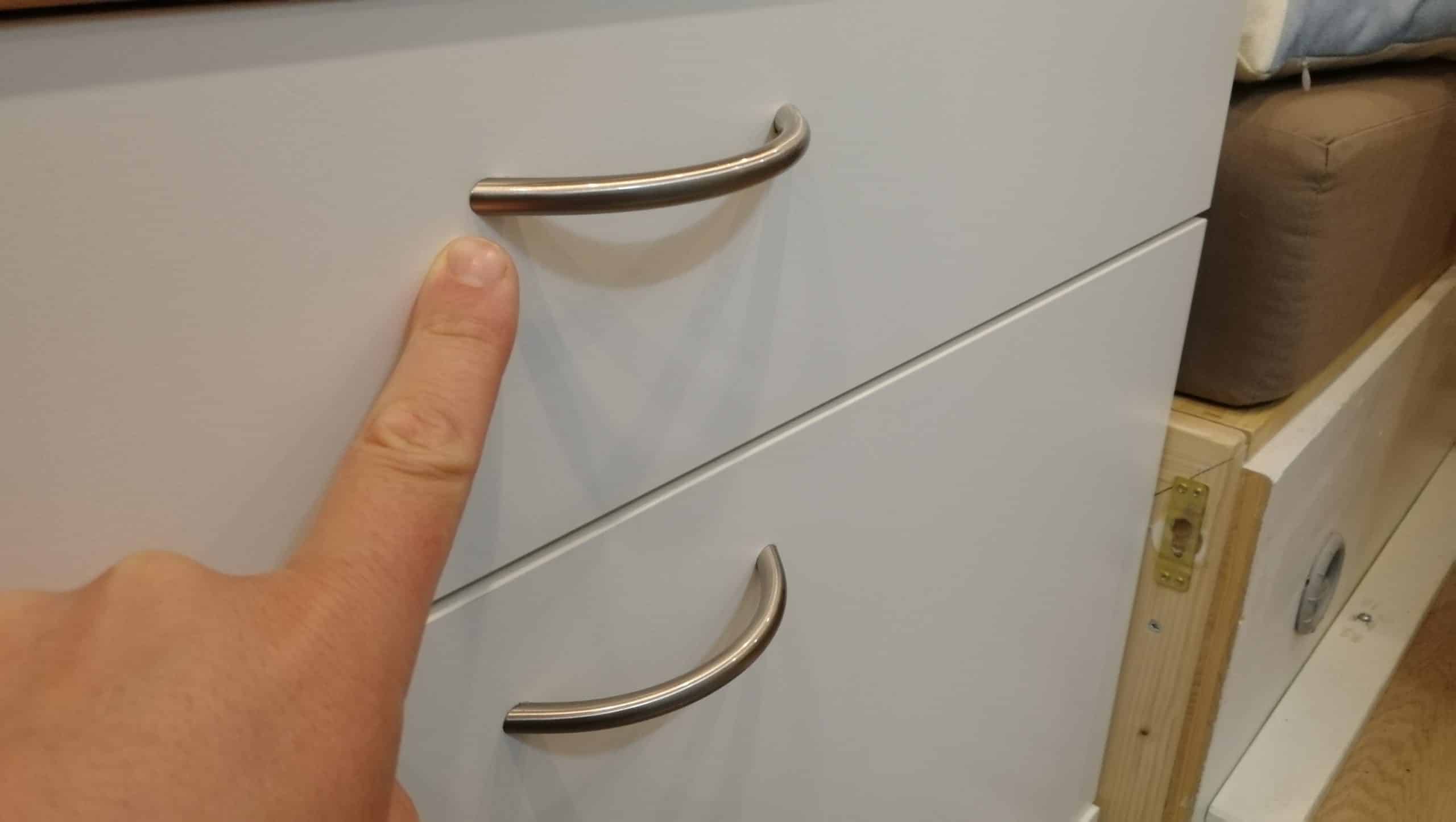

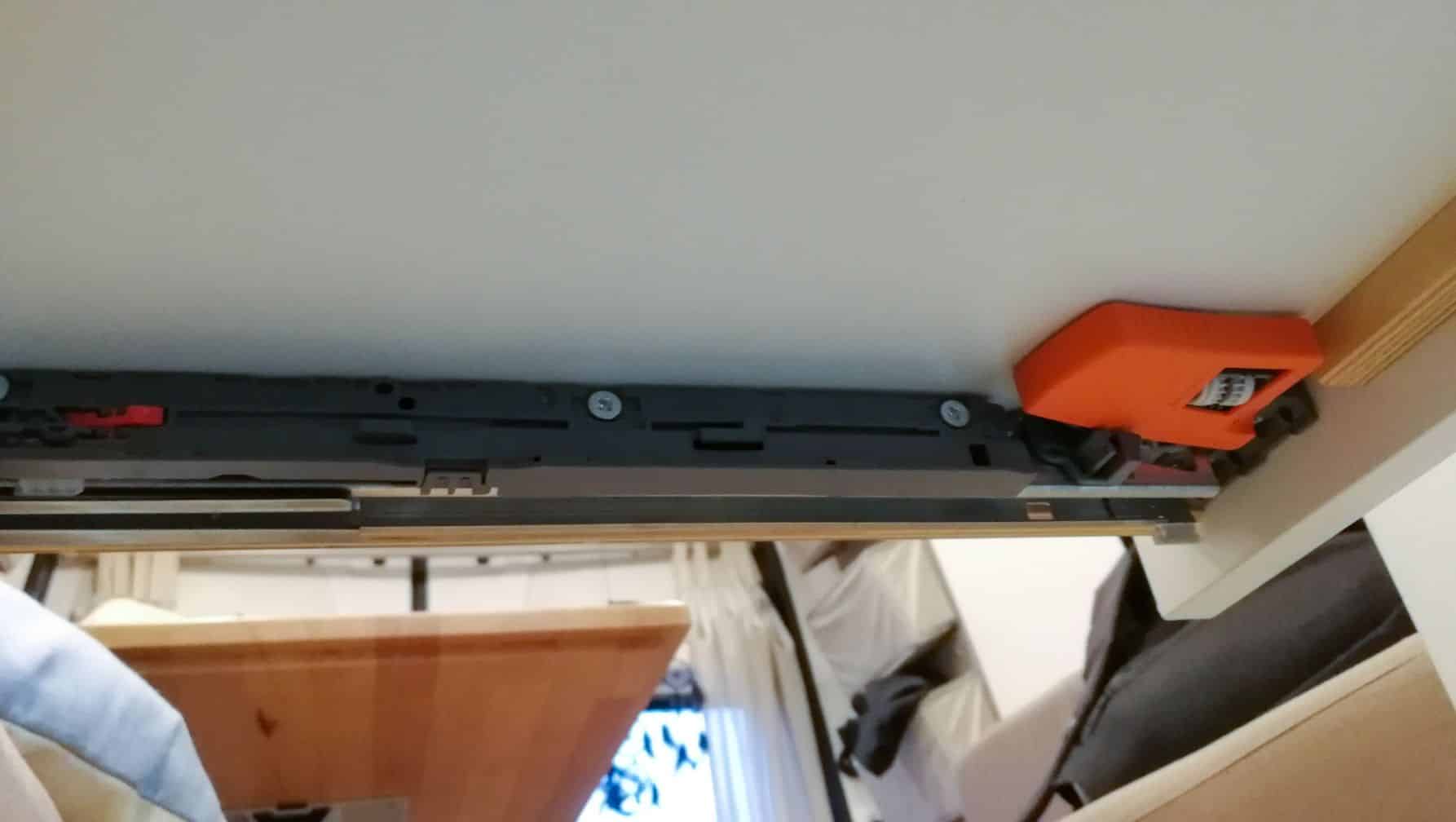
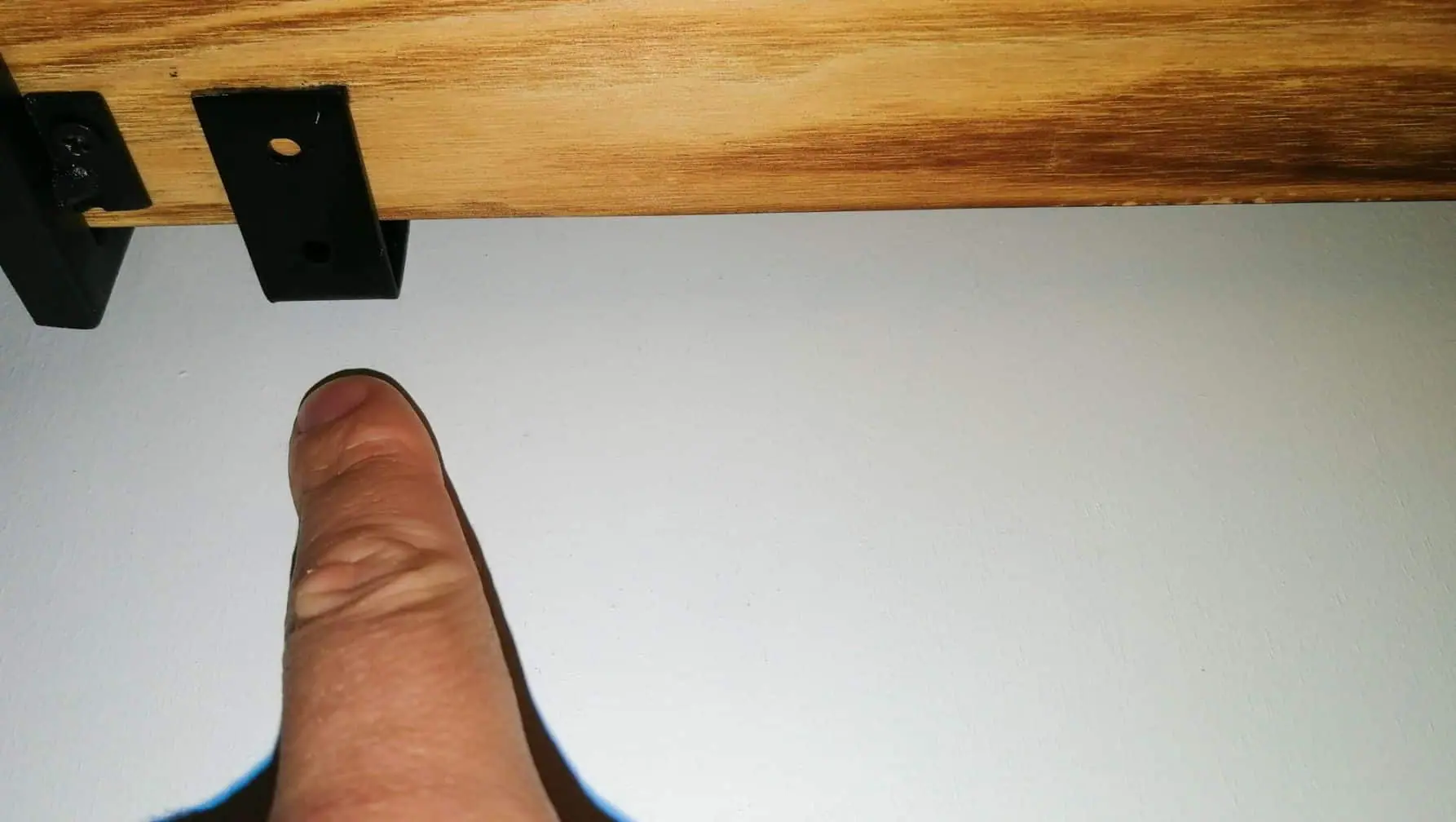
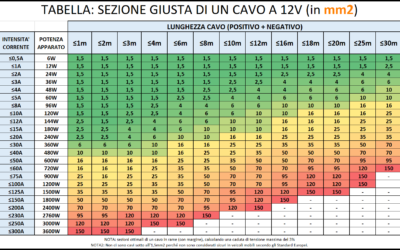
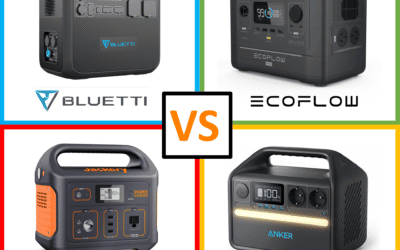

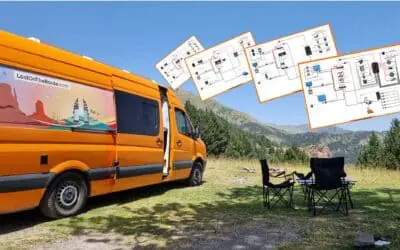


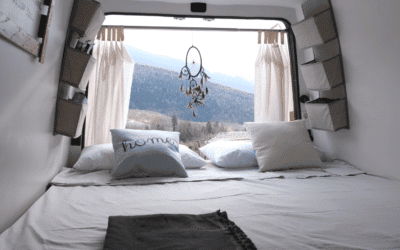

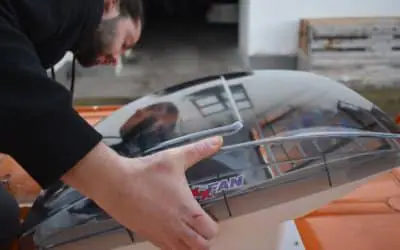
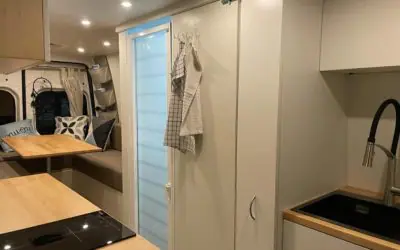
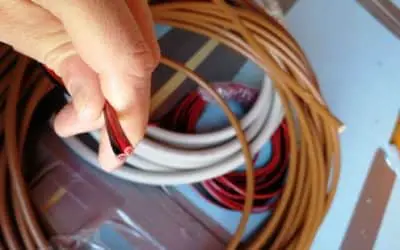
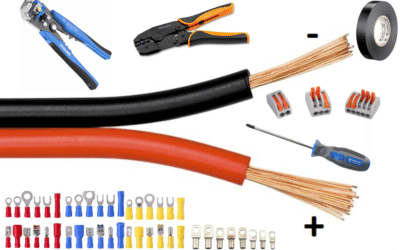



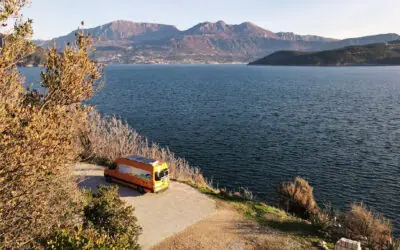
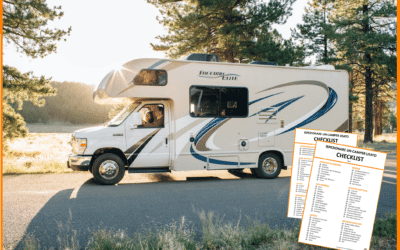


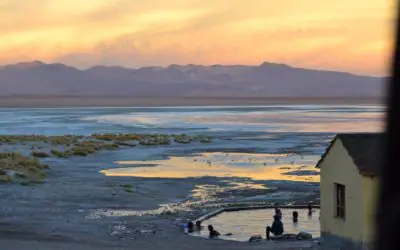
Thanks for posting this great article!